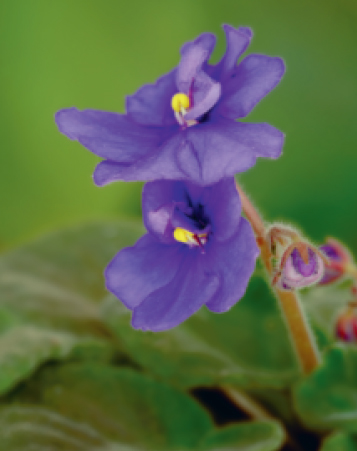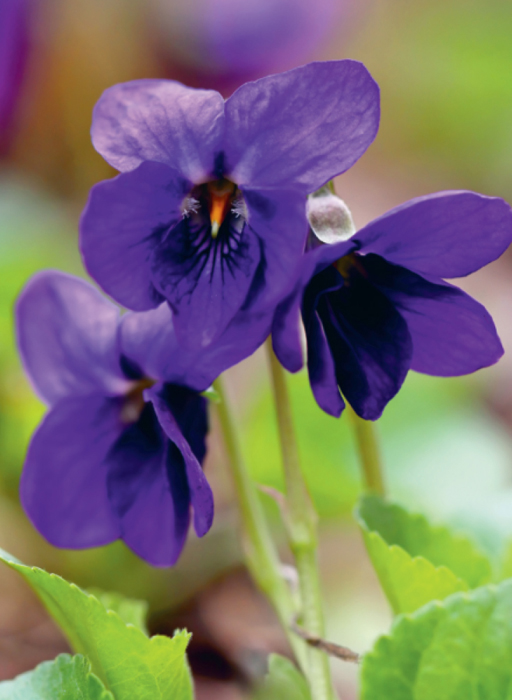
Scent – violet-like, woody-floral, slightly green, rich, sweet, uplifting, soothing.
Acacias, or wattle, are attractive evergreen or semievergreen trees, with strongly scented, fluffy yellow flowers that bloom in either spring or winter. There are more than 400 varieties, many of which are found in the tropics or subtropics of Australia, South America or Africa. Mimosa (A. dealbata), also known as the silver wattle, is a native of Australia but has naturalised across much of Africa and southern Europe. It was first introduced into Europe in the early nineteenth century as an ornamental evergreen plant for its delicate silvery-green foliage and fragrant lemony yellow flowers, produced from late winter to early spring. Mimosa is now cultivated in France and Spain especially for its perfumery value.
Mimosa can withstand a minimum temperature of -5°C (23°F): with the right protection it can be grown outside in a sheltered position in colder climates, provided the plant is wrapped up in horticultural fleece if there is danger of a hard frost. If mimosa is grown in a container it needs vigorous pruning to keep it from growing too tall – trees can reach heights of more than 12m (40ft). Conservatory specimens can be moved outside to a sunny position during the summer. Acacias like well-drained soil and full sun and are best propagated by seed sown in spring or by semi-ripe cuttings in summer.
A. ulicifolia is a frost-hardy dwarf variety (1m/3ft high) with clusters of pale yellow flowers in spring. Some of the more outstanding wattle trees for a conservatory are undoubtedly A. baileyana, the Cootamundra wattle from New South Wales, Australia, which has striking blue-green foliage, and Oven's wattle (A. pravissima) with bright yellow flowers – both reach about 5m (16ft) high. A deeper yellow flower is found in the Queensland silver wattle, A. podalyriifolia, which flowers both in winter and spring, as does A. retinodes, which is sweetly scented.
• Aromatherapy applications – An absolute is produced from the fresh flowers and twigs of A. dealbata mainly for use in expensive perfumes. It also has excellent fixative properties. In aromatherapy, mimosa is used in astringent skin ointments and for treating stress-related conditions such as anxiety, over-sensitivity and depression. A. farnesiana or sweet acacia is used to produce the perfumery material cassie. In India, its dried flowers are added to baths for their skin-toning properties. They are also prepared in the form of an infusion as a cosmetic aid – see page 76.
• Drying and decorative uses – Fresh mimosa flowers look beautiful in naturalistic arrangements; the dried bark can be burnt to produce a musky, leather-like incense, while the dried flowers of sweet acacia and mimosa can be added to pot pourris.
• Culinary suggestions – Cassie is used in minute amounts for flavouring confectionery and soft drinks; the ripe seeds are pressed for cooking oil.
• Health-giving properties – The bark of mimosa contains 42 per cent tannins and is employed medicinally for the treatment of diarrhoea and as an astringent gargle and ointment. Many acacia species have native medicinal uses: for example, the Senegal acacia (A. Senegal) yields a sticky exudation from its trunk known as gum arabic, which is used extensively as a demulcent.
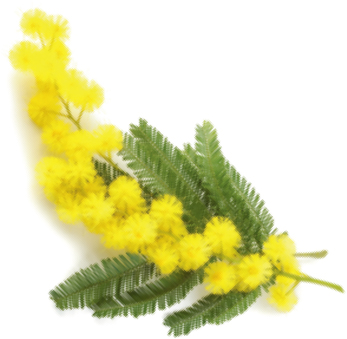
Scent – fresh, green, sweet, herb-like, slightly camphoraceous, restorative, revitalising, tonic.
Yarrow is one of the oldest known medicinal plants, named after the heroic warrior Achilles due to its outstanding healing qualities. Its dried straight stems are used to make the divination sticks for the Chinese ‘I Ching’ oracle and in the West too it has also traditionally been associated with divination and magic. Yarrow is an unassuming perennial herb, with a straight stem up to 1m (3ft) high and finely dissected greyish-silver leaves giving it a lacy appearance. It bears numerous pinky-white dense flower heads from summer into autumn.
Common throughout Europe, Asia and North America, where it can be found growing wild on wastelands, yarrow is an easy plant to grow and will survive even the most inhospitable conditions such as very dry, salty or windswept situations – though it does not like heavy soils. It is a prolific grower and spreads rapidly via its creeping rootstock, but although it is invasive, it is not hard to control by digging up established clumps each spring and dividing or discarding surplus growth. Yarrow thrives in a sunny position where the warmth of the sun draws out the plant's aroma: both the flowers and the leaves are richly pungent.
The cultivars ‘Cerise Queen’ (deep pink), ‘Fire King’ (rich red) and ‘Moonshine’ (bright yellow) are particularly striking, the last being smaller in stature (60cm/2ft), making it suitable for the front of a border. Plants from A. ptarmica The Pearl Group have very pretty, pompon-like white flowers and are mid-height with glossy green leaves; A. filipendulina makes a lovely tall plant for the back of the border with stiff erect stems and yellow flowers; A. grandifolia is the giant of the yarrows and makes a dramatic statement.
NOTE
Avoid during pregnancy.
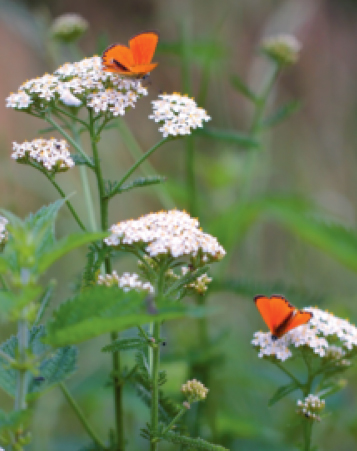
• Aromatherapy applications – An essential oil is made by steam distillation from the dried flowering herb. The oil is used with massage to reduce hypertension and insomnia and to treat stress-related conditions. Yarrow also tones the blood vessels, and is used to treat varicose veins, arteriosclerosis and high blood pressure. The flower water has an astringent and toning effect on the skin and is good for a wide range of skin conditions including acne, eczema, inflammations and scars – see page 74.
• Drying and decorative uses – The flowers of all forms of yarrow dry well and can be used in pot pourris, sweet bags, etc. The cut stems are ideal for fresh and dried flower arrangements. An infusion of yarrow makes a good hair rinse and promotes hair growth.
• Culinary suggestions – Try adding the young leaves of A. millefolium sparingly to early summer salads.
• Health-giving properties – Highly valued, particularly for its anti-inflammatory, antiseptic and wound-healing qualities, yarrow is also one of the best herbal remedies for fever. For an uplifting tonic tea, add 1 tablespoon of dried flowers to 600ml (1 pint) boiling water, infuse well and add honey to taste.
Scent – sharp, slightly acrid, onion-like, green, stimulating, fresh.
Some of the most invaluable plants in the herb or kitchen garden are alliums, better known as garlic, onions and chives. Besides being valuable for cooking, garlic (A. sativum) has traditional medicinal properties and was used extensively throughout history by the ancient Egyptians, Greeks and Romans, and right across the Middle and Far East and Europe. Onions (A. cepa), of which there are numerous cultivars now available, also possess outstanding medicinal and culinary qualities.
Chives (A. schoenoprasum) demonstrate many of the same properties as garlic and onions and are mentioned in early Chinese herbals. They have a milder flavour and a less intense aroma than either garlic or onions, making them more versatile as garden plants. A clump of chives makes a colourful addition to any herb garden or border with their striking mauve or rose-pink clustered heads. Native to Europe, Australia and North America, they thrive in hot sun and like a rich, moist soil – they also enjoy the addition of left-over coffee grounds to their soil. Without nutrients and plenty of water the leaves soon begin to turn yellow and wilt.
Planted under roses, chives, like garlic, act as an aphid repellent, prevent black spot and help intensify the perfume of the roses; planted next to apple trees, they help prevent scab. Chives make very attractive edging plants and will flourish in window boxes or in pots. A heavy frost will make them die back in winter, so bring a pot into the house for a fresh all-year-round supply. Easy to grow from seed, chives can also be propagated by bulb division – indeed, it is best to lift established clumps every few years and divide them.
There is also a white form, a fine-leaved variety and a pink form of A. schoenoprasum. The so-called garlic chives (A. tuberosum) have starry white flowers and a sweet garlic flavour. Instead of chives, the larger evergreen Welsh onion (A. fistulosum) can be grown and used in the winter months; the tree onion (A. cepa Proliferum Group) is useful in salads and stews. There are also several ornamental allium species which have scented flowers, such as A. stipitatum.
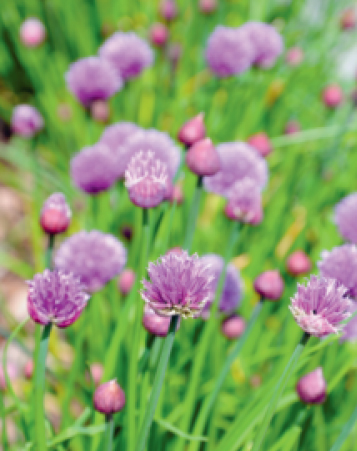
• Aromatherapy applications – Essential oils are produced from many allium species, including onions (A. cepa and A. fistulosum), garlic, chives and garlic chives. Valuable for flavouring, they are rarely used in aromatherapy work because of their pungent smell.
• Drying and decorative uses – Flower heads can be dried and used in pot pourris, but the leaves of chives do not dry well. Instead, a pot of fresh chives makes a useful and colourful kitchen addition. The more decorative allium species are valuable for use in fresh flower arrangements.
• Culinary suggestions – Chives can be cut to within 5cm (2in) of the ground up to four times a year for culinary use. Because the flavour is relatively mild, they are best added at the end of the cooking or chopped as a fresh garnish onto egg or potato dishes, soft cheeses, salads or soups, or scattered over grilled fish and meat.
• Health-giving properties – Like garlic, chives can help to boost energy, detoxify the system and aid the digestion. They also possess mild antiseptic properties. For medicinal purposes, the most effective and convenient way to get the benefit of alliums is in the form of garlic capsules, taken internally.
Scent – lemony, fruity-floral, fresh, sweet, uplifting, refreshing, soothing.
This is one of the most beautiful, semi-hardy deciduous shrubs for a sheltered spot in the garden or for a cool conservatory. Lemon verbena has bright green foliage and delicate pale purple flowers. It produces woody stems with long, lush, graceful branches bearing very fragrant, lemonscented narrow leaves. Because of its delightful scent, it is a lovely plant to position near an entrance or by a seat where it can be appreciated. A native of South America, it was first brought to Europe by the Spaniards in the seventeenth century. In tropical conditions, it will reach a height of 5m (16ft) or more but in cooler climates it will not usually grow higher than 2m (6ft 6in). If it is grown outside, in temperate regions lemon verbena needs the warmth of a sheltered wall to survive for it will not tolerate temperatures below -10°C (14°F), and even so will benefit from being protected over winter with horticultural fleece. After winter, new growth can often be slow and it is best to wait until late spring to see if a plant has survived or not.
Alternatively, lemon verbena can be grown as a container plant and simply moved under glass at the end of the summer. It thrives in a rich but free-draining soil, in a sunny position and likes to be kept moist during the growing season. Trim the branches to about half their length in autumn to encourage bushy growth the following season. Plants are best propagated by softwood cuttings taken in late spring or by semi-hardwood cuttings taken in late summer (the seeds do not set well in cool climates).
NOTE
Lemon verbena is not to be confused with Verbena officinalis, a hardy herb known as vervain, or with the herb lemon balm (Melissa officinalis).
• Aromatherapy applications – An essential oil is produced by steam distillation from the fresh leaves, mainly for use in perfumery and particularly to produce eau de verveine. However, the oil is phototoxic and also is frequently adulterated with other lemon-scented oils, such as that from the plant Litsea cubeba. Hence it is little used in aromatherapy for these reasons, although it does have value therapeutically for stress-related disorders and digestive complaints. To make a flower water at home, see page 74.
• Drying and decorative uses – Dried leaves will retain their fragrance for several years and are ideal for use in pot pourris, bath bags (fresh or dried), herb pillows and for all kinds of scented sachets.
• Culinary suggestions – Use fresh leaves to flavour oil or vinegar (see page 36), to add to salads and as a garnish for all sorts of fruit drinks, puddings, ice creams, etc.
• Health-giving properties – Sharing similar medicinal properties to lemon balm, the fresh or dried leaves make a deliciously uplifting yet soothing tea that is also good for digestive upsets of nervous origin.
NOTE
Prolonged use of the herb can cause stomach irritation.
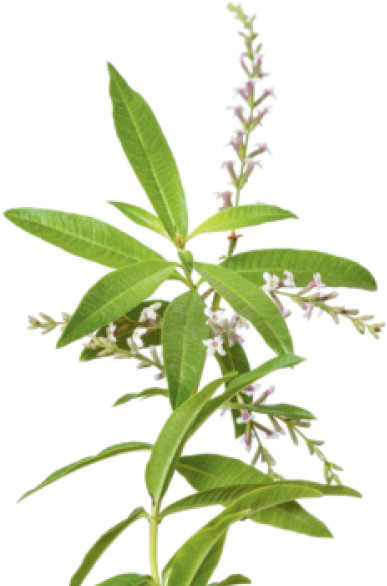
Scent – rich, herby-earthy, fresh-green, spicy, fortifying, pungent, purifying, warming.
Angelica is one of the most striking sculptural plants in the herb garden. The whole plant is powerfully aromatic: the ferny leaves have a pungent, fresh green scent while the large rhizome or root has a musky-earthy aroma. In early summer, umbels of sweet-scented greenish-white flowers rise from tall branches, which later in the year bear many spicy-scented seed heads. This is one of the earliest herbs known and comes from the cold climates of Russia, Lithuania and Iceland. The whole plant can reach a height of about 2.5m (8ft) with a 1m (3ft) spread, so it needs to be positioned at the back of a border or bed. Best planted in dappled shade, it likes a rich soil with plenty of moisture. Although angelica is a hardy biennial (a perennial if it is prevented from flowering), it dies down completely over the winter. It can easily be grown from seed sown in early autumn, although this is hardly necessary since it is a great self-seeder and will propagate itself year after year. Plants can also be propagated by root division, which should be carried out at the end of the growing season.
The American angelica (A. atropurpurea) shares similar properties with A. archangelica but only grows up to 1.5m (5ft) high, making it more suitable for smaller gardens. Wild angelica (A. sylvestris) is also a smaller plant, but is not suitable for culinary use.
• Aromatherapy applications – The seed oil is mainly used for ‘damp’ conditions such arthritis, gout, rheumatism, oedema, colds and coughs; also for digestive disorders and nervous debility. An aromatic water made from the distilled leaves revitalises dull and congested skin. See page 74 for instruction on making flower waters.
• Drying and decorative uses – The dried chopped root or root latex makes an excellent pot pourri fixative; seed heads can be used in dried arrangements.
• Culinary suggestions – The leaves, stem, root and seeds can all be used in cooking and the fresh leaves add zest to salads, soups and stews. The tender stems are traditionally candied and used to decorate cakes, while the dried root is used in breadmaking and the seeds for flavouring pastry.
• Health-giving properties – An infusion made from the fresh leaves or seeds has soothing, digestive and restorative properties. The Chinese angelica (A. sinensis) is a very effective tonic, comparable to ginseng, but specifically for women.
NOTE
Best avoided during pregnancy and by diabetics.
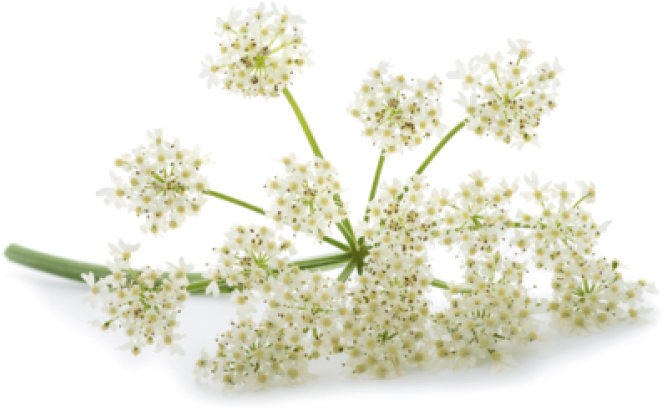
Scent – bitter-sweet, peppery, warm, herby, sharp, slightly anise-like, stimulating.
Artemisia is a large genus that contains some of the bitterest aromatic herbs known, including tarragon, wormwood (A. absinthium), southernwood (A. abrotanum) and sagebrush (A. californica). Many have pronounced medicinal properties but it is the unique scent and sharp herby-green flavour of tarragon that makes it indispensable for the fragrant herb garden. French tarragon (A. dracunculus) is a half-hardy perennial herb, with narrow green aromatic leaves and small yellowish flowers. In warm climates it will grow all year round, but in colder regions it will die back after the first frosts. As a native of southern Europe, French tarragon is slightly tender and in cold areas it is a good idea to cover the roots with a mulch before winter sets in. Alternatively, it is happy to be grown outside in big pots over summer and then moved to the protection of a cold frame or greenhouse in autumn. It likes plenty of warmth and a free-draining soil, so plants grown in pots need plenty of crocks for drainage.
French tarragon grows to about 1m (3ft) tall in a single season and although it does not have the most decorative of flowers, its fine dark green leaves and bushy shape contrast well with the foliage of other kitchen herbs, such as sage or chives. For culinary use, the flowers should be pinched out to encourage leafy growth. It is best to propagate French tarragon from cuttings or by root division, since it does not seed itself readily and much of the commercial seed sold as French is actually the Russian species (A. dracunculus dracunculoides). French tarragon plants should be replaced every three or four years as the flavour gradually deteriorates.
The Russian tarragon (A. dracunculoides) is a taller, more straggly plant 1.2m (4ft) high, with thinner, paler leaves and a milder, less refined flavour. It is, however, a completely hardy plant and will survive even the coldest of winters. Many of the other Artemisia species have decorative value for the herb garden or the border. Wormwood (A. absinthium) has finely divided, silvery evergreen leaves with a pungent bitter aroma; the cultivar ‘Lambrook Silver’ is smaller with even more finely divided leaves. Southernwood (A. abrotanum) is a very attractive semievergreen plant with feathery olive-green leaves and a fruity-green scent. It grows to about 1m (3ft) high and bears yellow flowers in spring and early summer. It even does well in polluted cities. Californian sagebrush (A. californica) has delightfully citrus-scented leaves. Mugwort (A. vulgaris) is a renowned ‘magical’ herb used for female ailments, while white mugwort (A. lactitlora) is valuable for dried flower arrangements.
NOTE
Avoid using all species during pregnancy.
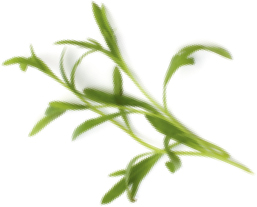
• Aromatherapy applications – An essential oil (estragon) is produced by steam distillation from the leaves of French and Russian tarragon. In aromatherapy it is used in moderation for digestive and genito-urinary problems. Essential oils are also produced from a wide selection of artemisias for use in perfumery and flavouring, including wormwood, southernwood, davana (A. pallens) and mugwort. All contain relatively large amounts of estragole, a moderately toxic constituent, and should therefore be avoided.
• Drying and decorative uses – Apart from tarragon, many of the artemisias dry well for use in decorative arrangements. In addition, all the species mentioned here have moth-, flea- and insect-repellent properties, making them ideal for linen sachets and posies.
• Culinary suggestions – One of the most valuable culinary herbs, tarragon can be used fresh all year round if protected. Apart from being the main ingredient in sauce Béarnaise, it complements many dishes, especially fish, rice, chicken, egg and salads. Good for infusing in oil or vinegar.
• Health-giving properties – Many species have powerful antiseptic and anti-infectious properties and were previously used to combat epidemics such as the plague or jail fever. Due to their potency, however, they should only be administered by a professional herbalist. But a mild tea made from the leaves of French tarragon can be safely used to boost the whole system and to stimulate the appetite.
Scent – green-herby, sharp, pungent, refreshing, cleansing.
This familiar herb of ancient medical repute is now more often cultivated as a decorative plant than for its practical uses. Its bright golden-orange, daisy-like flowers are in bloom almost continually and will bring a splash of colour to the herb garden or border whatever the time of the year. In fact, the marigold is named Calendula from the Latin calendae, the first day of the month, since it is said that the plants can be found in flower at the beginning of every month.
The common marigold is a hardy annual, growing up to 60cm (2ft) high with soft, bright green leaves and many cheerful flowers. The whole plant is strongly aromatic, especially the leaves. Found growing wild right across the Mediterranean region, it will tolerate most situations, but prefers a well-drained, loamy soil and a sunny position. A single plant will flower over a long period if it is deadheaded regularly, but will eventually die down in winter. Marigolds self-seed readily but can easily be propagated if required by seed sown in autumn (for early spring flowers) or in spring (for a later show). Some gardeners find it makes an excellent companion plant, as it helps to keep away insect pests (especially whitefly) from surrounding flowers, herbs and vegetables.
NOTE
Avoid using all species during pregnancy.
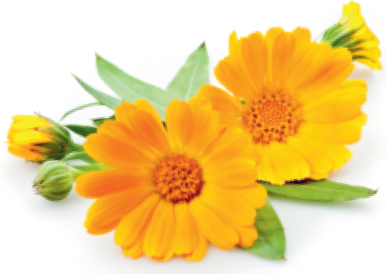
There are many cultivars of the common marigold now available with yellow, red or double flowers, including ‘Prolifera’, which has multi-headed flower stems. This is not to be confused with the so-called French marigold (Tagetes patula), a strongly scented half-hardy annual about 30cm (1ft) high with bright orange daisy-like flowers and deeply cut green leaves.
• Aromatherapy applications – True calendula absolute is produced from the fresh flowers of C. officinalis. It is, however, an expensive product and difficult to get hold of. In aromatherapy, the infused oil or cream is more commonly used for the treatment of a wide range of skin complaints and injuries including cracked skin, scars, eczema, rashes, viral infections and inflammations. To make your own infused oil at home, see page 76. An essential oil is also produced from Tagetes patula and – confusingly – it is also called calendula oil. It has a bitter-green odour and is moderately toxic and of limited use, but is sometimes used in the treatment of bunions, calluses, corns and fungal infections.
• Drying and decorative uses – The dried flower heads add zest to pot pourri and impart a golden tint to brown hair if used as a final rinse. Use the fresh flowers in bath bags as a skin healer. In the East, marigolds are commonly used in garlands and at festivals for their bright, decorative effect.
• Culinary suggestions – Add fresh petals to fish dishes and to salads; the flowers can also be cooked with rice to add a golden colour (they are often used as a saffron substitute). The leaves were once used in soups and stews to ‘comfort the heart and spirits’, and gave rise to the name pot marigolds (as they were added to the cooking pot).
• Health-giving properties – Applied externally, C. officinalis was used extensively during the First World War and in the American Civil War to treat wounds and to prevent sepsis: the flowers were made into a poultice or used to produce an infused oil. A standard infusion or tea can help heal internal wounds – such as those caused by mouth ulcers, stomach ulcers or colitis. The infusion stimulates the lymphatic system, reduces glandular swellings and helps cleanse the body of impurities.
Scent – warm, sweet, fruity-herby, earthy-green, apple-like, profoundly soothing, relaxing.
Roman chamomile is a low-growing evergreen perennial with feathery leaves and sweet-scented, daisy-like white flowers. The whole plant has an apple-like scent and is in flower all summer. It is an ancient medicinal plant and was one of the nine sacred herbs of the Saxons. Chamomile is renowned historically for the fragrant lawns and seats so beloved of the Elizabethans, and examples can still be enjoyed in several historic gardens today, including Buckingham Palace in London. The best chamomile for a lawn is the non-flowering, miniature variety ‘Treneague’, otherwise the flowers require constant cutting. Although it only grows to about 10cm (4in) high it has a spread of 45cm (18in), making it an ideal ground cover plant.
Chamomile is best planted in the sun and prefers a welldrained soil. It has a beneficial effect on other plants growing nearby, and is thus known as the physician's plant. Even cut flowers last longer if chamomile tea is added to their water. Plants can be propagated by seed planted in spring (both Roman and German species), by cuttings or by division of established plants. See page 86 for instructions on how to plant a chamomile seat.
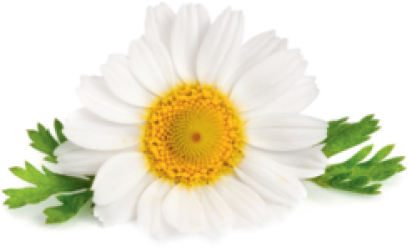
Low-growing C. nobile ‘Treneague’ and the doubleflowered cultivar C. n. ‘Flore Pleno’ are very compact – ideal for lawns or for planting between paving. The German chamomile (Matricaria recutita) is an annual hay-scented herb, up to 60cm (2ft) tall with delicate feathery leaves and simple, daisy-like white flowers which are smaller than those of Roman chamomile. This herb has potent medicinal properties. The short-lived perennial dyer's chamomile (Anthemis tinctoria) is an attractive plant for the border and it grows up to 1m (3ft) tall, with bright yellow daisy-like flowers and a mossy-green scent.
• Aromatherapy applications – Essential oils are produced from several species of chamomile including Roman, German and the Moroccan chamomile (C. mixta). The most valuable oil in aromatherapy is known as chamomile blue, extracted from the flower heads of German chamomile (Matricaria recutita). It's an inky-blue viscous liquid with a strong sweet-herby odour. It contains the powerful anti-inflammatory and sedative constituent chamazulene, which is not present in the fresh flower but is produced only during the process of distillation. In aromatherapy, both Roman and German types are used for a wide range of skin complaints including acne, allergies, eczema and inflammations. They are also extremely valuable herbs for soothing pain caused by headaches, periods, indigestion, earache, inflamed joints, muscular sprains or spasm and for treating stress-related complaints. A soothing massage oil and a flower water that helps heal the skin can be made from the fresh flower heads – see pages 74 and 76.
• Drying and decorative uses – Dry flowers of all species for pot pourris and herb pillows. The dried or fresh flowers can be used to make soothing bath bags; chamomile water can also be used on fair hair to keep it light and in good condition.
• Culinary suggestions – Chamomile flowers steeped in boiling water and served with a spoonful of honey make a soothing nightcap.
• Health-giving properties – The healing properties of chamomile are too numerous to list here, although it is best known for its antispasmodic, digestive, sedative and tonic effects. A very safe and mild herb, it is often used for children's complaints, such as insomnia, teething pain, colic or tummy upsets – either in the form of a weak tea or as a massage oil.
Scent – rich, sweet, balsamic, resinous, herby, slightly musky, warming, restorative, soothing, comforting.
Cistus, otherwise known as rock or sun roses, have open cup-shaped white, yellow or pink flowers and bloom profusely throughout the summer. As fast-growing evergreens, they make ideal rockery or border plants but they do need some shelter as they resent frost – a free-draining bed beneath a sunny wall is ideal. These plants are found in the Mediterranean areas right up to the Caucasus. Gertrude Jekyll wrote:
Among the sweet shrubs from the nearer of these southern regions, one of the best for English gardens is Cistus. laurifolius. Its wholesome, aromatic sweetness is given off even in winter. In this, as in its near relative, C. ladaniferus, the scent seems to come from the gummy surface, and not from the body of the leaf.
(The Gardener's Essential Gertrude Jekyll)
Her observation is hardly surprising since it is the sticky resinous gum, known as labdanum, which gives these plants their characteristic balsamic scent. The resin (found on the leaves and stem) was formerly collected by shepherds on the island of Crete by combing the sticky gum from the fleeces of sheep and goats that had brushed against it while grazing. C. ladanifer will grow up to 3m (10ft) tall in a protected position and has soft lance-shaped grey-green leaves (white on the underside) and white flowers with crimson blotches. Plants should be trimmed lightly in spring and after flowering to maintain a compact shape and to prevent them getting too woody – but avoid hard pruning, which can prove fatal. Cistus are best propagated by seed sown in spring or autumn, or by softwood cuttings taken in summer.
An exceptionally hardy pink cistus is C. ‘Silver Pink’; other hardy species are C. laurifolius, which has white flowers with a yellow centre, and C. x cyprius, which is white with crimson blotches. C. x aguilarii produces huge white flowers which are very impressive but the plant is not hardy in severe winters. C. ‘Peggy Sammons’ has delicate pink flowers and green-grey foliage; another pale pink cistus, also very beautiful, is C. x skanbergii, a small shrub which grows wild in Greece. C. x pulverulentus ‘Sunset’ is a short compact shrub with vivid magenta flowers and an orange centre.

• Aromatherapy applications – An essential oil is produced by steam distillation of labdanum gum or from the leaves and twigs directly. The oil (and absolute) is an important perfumery material (similar to ambergris) and many species are used, notably C. ladanifer and C. creticus subsp. incanus. In aromatherapy the oil is valued for its warming, mildly erotic qualities – good for depression, grief or shock. The dark brown crude oleo-resin or gum can be obtained by simply boiling the plant material in water at home.
• Drying and decorative uses – The dried leaves (or the oleo-resin) can be burnt as a fumigant or incense. Dried leaves can be added to pot pourris for their tenacious scent.
• Culinary suggestions – The oil is used commercially for flavouring a wide variety of foods, especially meat products – but is little used in home cooking.
• Health-giving properties – Labdanum gum is an ancient aromatic material, traditionally used in skincare ointments because of its antiseptic and astringent properties.
NOTE
Avoid using all species during pregnancy.
Scent – fruit: fresh, citrus, rich, sweet, warm, comforting. flowers: sweet-floral, honey, delicate, soothing, aphrodisiac, sedative, uplifting. leaves: fresh-green, citrus, slightly herby, refreshing.
The bitter orange tree or Seville orange is one of the most versatile aromatic species. It produces three different types of essential oil, each with a distinct perfume, from various parts of the plant: orange oil from the fruit, neroli oil from the flowers and petitgrain oil from the leaves. The bitter orange is a very handsome evergreen tree up to 10m (33ft) high with dark green, glossy oval leaves, and long but not very sharp spines. It has a smooth greyish trunk and branches, and very fragrant large white flowers. The bitter fruits have an aromatic rind and are smaller and darker than the sweet orange.
Native to China and north-east India, the Seville orange is now cultivated all over the world, especially in the Mediterranean. It was the first citrus species to be brought to Europe by the Portuguese in the twelfth century. In colder northern European climes, most citrus species need protection against frost and must be overwintered under glass. They require a minimum temperature of 7°C (45°F), plus a rich but well-drained soil, plenty of sun, and like to be well watered during the growing season but sparingly in winter. Plants can be propagated by seed (although cultivars do not come true from seed) or by semi-ripe cuttings taken in summer.
There are now numerous different citrus species available to the gardener. The sweet orange tree (C. sinensis) is a smaller evergreen tree than the bitter variety and is less hardy with fewer or no spines. The lemon tree (C. limon) makes an excellent conservatory plant and has various cultivars suitable for pot culture – ‘Variegata’ has interesting yellow-margined leaves. The mandarin tree (C. reticulata) can grow up to 8m (26ft) high and has very attractive miniature fruits, while the lime (C. aurantiifolia) is a smaller tree growing up to 5m (16ft) high with clusters of very fragrant white flowers in spring and summer.
NOTE
Many citrus peel oils are phototoxic – that is, they discolour the skin under UV light – and their use on the skin should be avoided if there is danger of exposure to direct sunlight.
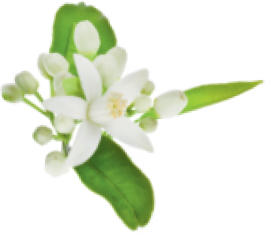
• Aromatherapy applications – Orange essential oil is produced by cold expression from the outer peel of the almost ripe fruit; petitgrain oil by steam expression from the leaves; neroli oil by steam distillation from the freshly picked flowers. In aromatherapy, the most valuable oil is that from the flowers, for it has a profoundly soothing effect on the entire nervous system and is used to treat anxiety, depression, nervous tension, PMT, shock and other emotional problems. Petitgrain and neroli oil also all have excellent skin-care qualities: they tone the complexion and are beneficial for all skin types, scars, stretch marks, thread veins and wrinkles. The distillation water, known as orange-flower water, is a popular cosmetic and household article; petitgrain oil is also a classic ingredient of eau de cologne. See pages 74–5 for making flower waters and eau de colognes.
• Drying and decorative uses – Orange flowers have many folk associations. Neroli oil was named after a princess of Nerola in Italy, who loved to wear it as a perfume (see page 75 for making a natural perfume). The fresh flowers were used in bridal bouquets and wreaths and are good for small posies and arrangements. Dried peel from all citrus species can be used in pot pourris. Dried oranges, either sliced or whole, have many decorative uses, especially at festive occasions. Oranges are, of course, the traditional base for pomanders.
• Culinary suggestions – Orange-flower water is used in cake making; the fruits and rinds of all the citrus species have flavouring and nutritional value.
• Health-giving properties – It is well known that oranges, lemon and most citrus fruit varieties are rich in vitamin C. Dried bitter orange peel is also used as a tonic and carminative in treating dyspepsia. On the Continent, an infusion of dried citrus flowers is used as a mild tonic for the nervous system, and also as a blood cleanser.
Scent – very sweet, floral, spicy, strong, strengthening, heart-warming, restorative.
In the seventeenth century, the herbalist Nicholas Culpeper evocatively described sweetly scented lily-of-the-valley as having ‘white flowers like little bells with turned-up edges’. It has been known by a number of charming names such as fairies’ bells, ladder to heaven or lady's tears. The white blossoms are traditionally associated with purity and the Virgin Mary, and they are still used in bridal bouquets today – they are indispensable for their delicate scent, which is not too cloying. Convallaria is a single-species genus, native to Britain, northern Europe and North America, especially in woodlands. Lily-of-the-valley is a hardy rhizomatous perennial that flowers in late spring. It prefers to be planted in shade or semi-shade, ideally where it can enjoy rich, moist earth that has been thoroughly manured and is freedraining. It has bright green, lance-shaped leaves and its creeping rootstock increases annually, and although the plant can be divided after flowering in autumn, in general it dislikes being disturbed. Lily-of-the-valley is a small plant, growing only 23–30cm (9–12in) high, but once settled, its rootstock spreads rapidly to form clumps.
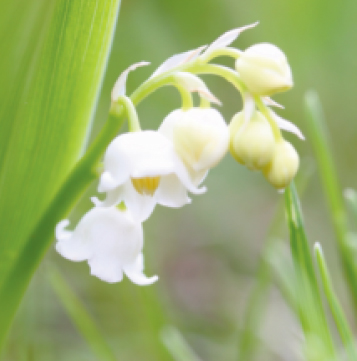
There are a couple of varieties of C. majalis with blooms that are predominantly white. C. majalis ‘Flore Pleno’ is a double variety with small, very fragrant flowers, while the larger-flowered C. m. ‘Fortin's Giant’ blooms slightly earlier in the spring. The leaves of C. m. ‘Variegata’ are attractively golden-striped. Two hundred years ago, there was reputedly a double form with flowers variegated purple and white, as well as a red. Of all the varieties, the rosy-pink C. m. var. rosea has the sweetest scent of all.
• Aromatherapy applications – As all parts of the plant are toxic, the oil is not used in aromatherapy. Today it is used (mainly in synthetic form) as a basis for perfume and toilet waters, although in the Middle Ages great healing qualities were attributed to the water distilled from the flowers, known as ‘aqua aurea’, and renowned as an astringent, beautifying skin tonic that also ‘comforteth the heart ... and strengthen the memorie’.
• Drying and decorative uses – The fresh flowers have traditionally been used for posies and last well in water. The fragrant flowers can also be dried for use in pot pourris.
• Culinary suggestions – Lily-of-the-valley is potentially poisonous and should not be used in cooking at all.
• Health-giving properties – Lily-of-the-valley was used for centuries in herbal medicine, especially as a heart tonic. According to a seventeenth century herbal, the distilled flowers in wine were considered ‘more precious than gold’. It was thought to be particularly effective against palsy and gout for it has diuretic properties when infused with water. C. majalis is still used by professional herbalists to regulate the heartbeat, as the dried plant contains a similar substance to digitalin extracted from foxgloves, but it is not suitable for home use.
NOTE
Lily-of-the-valley should not be used at home for therapeutic purposes due to its toxicity.
Scent – leaves: pungent, sweet, woody-spicy, revitalising, stimulating. seeds: warm, spicy, earthy, musky, aphrodisiac, sedative, slightly narcotic.
Coriander is a strongly aromatic herb with bright green, filigree leaves and umbels of lace-like white flowers, followed by a mass of round green seeds that ripen to brown. It has been cultivated for at least 3,000 years as a medicinal and culinary herb, although today it is best known as a flavouring in Middle Eastern dishes. Coriander is an annual that is easy to grow and can reach about 1m (3ft) high, but its delicate structure requires a sheltered position and protection from strong winds. It prefers full sun and a rich, light, well-drained soil – it does not like damp conditions. As well as the herb garden, try it in a naturalistic setting, planted in drifts. Coriander can also be grown in pots either outside or indoors. Plant the seeds in autumn or late spring (or early spring under glass) and water regularly until established. Coriander self-seeds readily, but seedlings do not transplant well so it is best to sow in situ and thin them out later. The seeds can be harvested once they turn brown, by shaking them from the flower heads.
• Aromatherapy applications – An infused oil can be made using the crushed seeds for massage purposes – see page 76. An essential oil produced from the seeds is used in aromatherapy primarily for digestive upsets and to stimulate the circulation and eliminate toxins. As a perfumery ingredient, it is used mainly for scenting soaps and toiletries, especially to provide a masculine note. It is also used in quality perfumes, for example Coriandre by Jean Couturier.
• Drying and decorative uses – The dried seeds were once called dizzycorn, because when freshly crushed, their scent can promote dizziness. Use them in sachets and pot pourris.
• Culinary suggestions – The leaves and seeds have two distinct flavours. The seeds can be dried and stored whole for use in curries, chutney, meat dishes, sweet puddings and for flavouring vinegar. The fresh young leaves can be used in salads, curries, stews and as a spicy garnish for oriental-style dishes.
• Health-giving properties – A tea made from the fresh leaves helps relieve indigestion and flatulence. If breastfeeding mothers drink coriander tea, it can help prevent colic in the baby.
NOTE
Coriander should not be planted alongside fennel, as the latter's seed production will suffer.
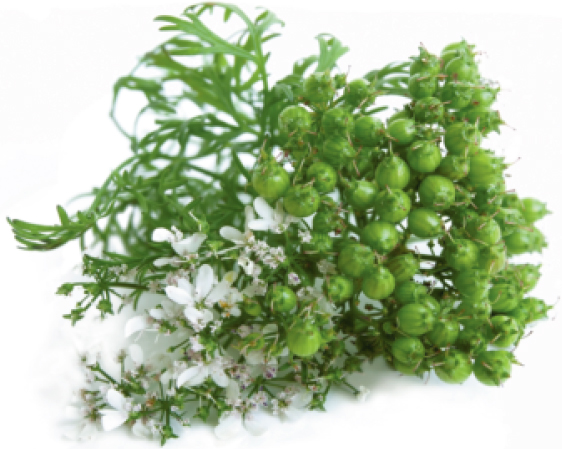
Scent – floral, clove-like, exotic, chocolate, warming, uplifting, aphrodisiac, intoxicating, comforting.
Carnations or clove gilliflowers, also known as pinks, are one of the most popular and ancient scented flowers in cultivation. In the seventeenth century, they were a favourite with gardeners and one of the best-loved florists’ flowers (see page 25). Theophrastus, in the fourth century BC, honoured carnations, calling them Dios-anthos, literally ‘flower of Zeus’ or ‘flower of the gods’, from which they took their Latin name. They were used to make garlands at festivals and crowns for coronations, hence their common name, carnations. It is thought that they were brought to England from southern Europe by the Normans in the Middle Ages.
Carnations and pinks are low-growing evergreen or semievergreen perennials, annuals and biennials, mainly grown for their scented pink, white or purplish flowers. Although not all species are scented, the majority are and they provide an abundance of perfumed flowers for cutting. Native to the Mediterranean and generally hardy, they prefer being planted in semi-alkaline soil in the sunshine. In the herbaceous border, it may be necessary to renew plants every couple of years as they die from excessively kind treatment.
In late summer, border carnations can be propagated by layering; others can be propagated by cuttings in late spring or by seed. D. caryophyllus, the original wild rose-pink carnation, is the parent of today's hardy border carnations. In midsummer, they carry double (or semidouble) flowers which are richly perfumed with a spicy clove scent.
A number of modern carnations have lost their scent, but one of the best fragrant varieties is the rosy-pink double D. caryophyllus ‘Chabaud Giant Double’, while the deep crimson D. ‘Bookham Perfume’ is thought to have the strongest clove fragrance. The source of most scented cottage pinks is the hardy D. plumarius.
D. barbatus, the perennial sweet william from eastern Europe, is a very old garden plant first described in the sixteenth century and ranges in colour from white through to pink and crimson-purple. Highly fragrant, with a sweet, spicy, clove-like scent especially pronounced in the evenings, it also has the virtue of flowering all summer.
The strongly fragrant white double garden pink ‘Mrs Sinkins’ is an old favourite, as is ‘Sops-in-Wine’, another old-fashioned fragrant variety known since the fourteenth century which has single maroon flowers, marked white. Modern pinks derive from the hybrid group D. x allwoodii, which is a cross between the old-fashioned pink and perpetual-flowering carnations. They are generally hardier and more vigorous than the old-fashioned pinks.
• Aromatherapy applications – Oil distilled from the fresh flowers of D. caryophyllus is mostly produced in France and Egypt. The richly perfumed oil is honey scented with a touch of clove and its effect is simultaneously warming and aphrodisiac. As its actions are uplifting, it is suitable as an antidepressant but also has anti-bacterial and anti-fungal properties. Although not specifically used in aromatherapy, it can be burned to scent a room or used as a perfume.
• Drying and decorative uses – Use fresh flowers in tussie mussies – traditional Elizabethan posies of aromatic herbs and flowers (see page 78) – and decorative arrangements. The scented dried petals of pinks make an attractive addition to pot pourris; use them combined with other dried aromatic flowers in scented pillows and bags. Bunches of dried pinks also burn well on an open fire, fragrancing the room.
• Culinary suggestions – The flower petals can be used in salads (but be sure to remove the white heel first as this is extremely bitter). Their clove flavour can also be used to flavour soups, wine, liqueurs and syrups and to add a spicy flavour to wine vinegars. Additionally, the flowers can be crystallised in sugar or simply used decoratively in puddings.
• Health-giving properties – Reputedly good for the nerves, the flower petals of D. caryophyllus, infused in wine, can be used to make a simple health-giving medicinal tonic.
NOTE
Avoid using all species during pregnancy.
Scent – citrus, lemon-peel, balsamic, resinous, minty, astringent, refreshing.
Burning bush or dittany is an upright, long-lived herbaceous hardy perennial native to south-west Europe and Asia Minor. The plant's most common popular name derives from the inflammable lemon-scented oil vapours given off by the flowers in hot weather. These either ignite spontaneously or can be lit with a match, producing a blue flame. Not only the flowers but also the leaves have an aroma reminiscent of lemon-peel when rubbed. These can cause a rash to those with sensitive skins. The oregano species Origanum dictamnus has a similar scent and this is probably the source of its nomenclature. Burning bush is a striking plant, growing to 1m (3ft), with hairy stems and light green divided leaves. It makes an unusual and attractive addition to a flower border, especially grown in large clumps, but can look equally stunning in a more naturalistic setting – in its native conditions it grows wild in dry scrub and pine woods. Although it requires some patience, plants can be grown from seed planted in open ground in late summer. It is preferable to plant in situ, but if you choose to transplant seedlings, do so in autumn or the following spring and prepare to wait a few years before the plants flower. Generally the plants do not like transplanting or any disturbance, especially once they are established. Burning bush likes fertile, well-drained or dry alkaline soil and should be planted in full sun or only partial shade in warm sheltered areas. Young plants need protecting from slugs.
There is only one species in this genus. D. albus produces star-shaped fragrant white flowers in summer, occasionally marked with purple. The mauve-pink variety D. albus var. purpureus (syn. D. fraxinella) produces fragrant flower spires, streaked deeper purplish pink.
• Aromatherapy applications – An essential oil is produced for perfumery use from the leaves and flowers but it is not employed in aromatherapy. A perfumed distilled water using an infusion of scented flowers can be used as an astringent skin water – see page 74.
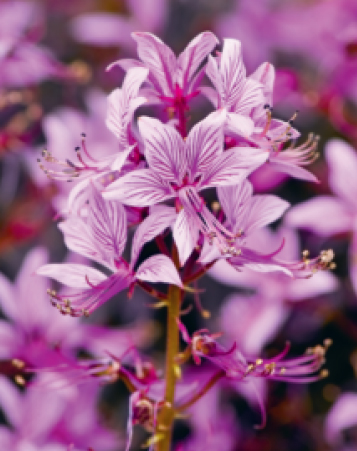
• Drying and decorative uses – The leaves and flowers of burning bush can be dried and used in pot pourris.
• Culinary suggestions – The scented leaves can be infused to make a fragrant uplifting tea.
• Health-giving properties – The bark from the roots of burning bush is used in Chinese medicine for dispelling pathogenic heat – an unnaturally high temperature, as in a fever. In the West, an infusion of its leaves was used to ameliorate nervous conditions, a root decoction to treat fevers and stomach cramps, and the root together with the seeds in the treatment of kidney stones. But none of these treatments is recommended today and burning bush is not suitable for medicinal home use.
NOTE
Avoid during pregnancy.
Scent – sweet, anise-like, slightly earthy-peppery, restorative, purifying.
Sweet fennel is a lovely plant for the back of a border or the herb garden. Its tall growth and bright green feathery leaves lend an air of softness to more defined bushes, such as old roses or woody herbs like lavenders or santolinas. It is not dissimilar to dill in appearance, though taller in stature, reaching up to 2m (6ft 6in) high, with umbels of tiny golden-yellow flowers which ripen into aromatic seeds.
Sweet fennel is native to the Mediterranean region and is naturally a biennial or perennial herb, although generally cultivated as an annual. It prefers a well-drained sunny position but will grow almost anywhere and will seed itself freely. Otherwise, sow the seeds in spring directly in the ground after all frosts have passed or earlier under glass; fennel can also be propagated by root division in autumn. If stems are cut right down in the summer, there will be a second flush of leaves.
NOTE
Avoid growing fennel near dill or coriander since they can cross-pollinate and reduce overall seed production.
There are two main varieties of fennel. Bitter or common fennel (F. vulgare) is slightly taller with less divided leaves. The cultivated sweet or Roman fennel is F. vulgare var. dulce. There is also a coppery-bronze variety, F. v. ‘Purpureum’, which is particularly striking.
NOTE
Fennel should be avoided by epileptics.
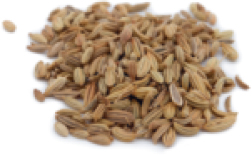
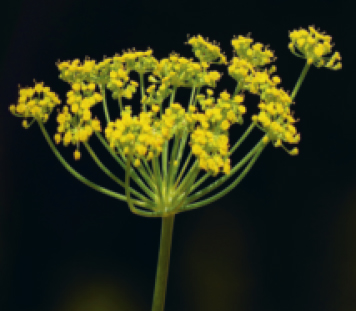
• Aromatherapy applications – An essential oil made from the seed is mainly used for congestive problems of the circulation, muscles and joints, notably cellulitis, obesity, oedema and arthritis. It is also valuable for the digestive system and for easing cramps. A flower water (for dull and congested skin) or infused oil for massage can be made from the fresh leaves and seeds – see pages 74 and 76.
• Drying and decorative uses – The fresh leaves are valuable for naturalistic flower arrangements. Fresh fennel also repels fleas and other insects. Harvest and dry the whole herb in bunches once the seeds have turned brown, and use the dried seeds for pot pourris.
• Culinary suggestions – Both the leaves and seeds have a strong aniseed flavour: fresh or dried leaves are delicious in fish dishes or salads; the seeds are traditionally used in chutneys and pickles. They also can enhance the flavour of borscht soup, Scandinavian-style bread and even some puddings. Bronze fennel makes vinegar a rich claret colour. Sweet fennel is also grown as a vegetable.
• Health-giving properties – Fennel seed (use 1 teaspoon of seeds per cup of boiling water) is a powerful tonic and nervine, and also a traditional digestive, taken after eating rich fare. A weak fennel seed infusion is the main ingredient in gripe water and can be used for colic in babies. Drinking fennel tea can help remedy insufficient milk in nursing mothers.
Scent – heady, exotic, sweet-floral, slightly spicy, aphrodisiac.
This tender evergreen shrub, with its glossy green leaves and pale ivory flowers, is one of the most beautiful conservatory or patio plants. Its waxy double flowers emit a heavy, spicy-sweet fragrance and, like freesias, they can perfume an entire room. Originally G. augusta came from China, so in cold climates it needs to be overwintered under glass. Although it requires more careful attention than many other pot plants, it's well worth the effort.
Ideally, a gardenia plant needs to be kept at a minimum temperature of 16°C (61°F) in a light position yet protected from direct sunlight. The soil should be kept moist at all times (using rainwater only) but not waterlogged. Indoor plants enjoy a regular misting, which helps to prevent the newly formed flower buds from dropping off; they also benefit from being moved outdoors once the weather is warm enough. With constant humidity and warmth a bush can grow up to 1.5m (5ft), flowering from mid- to late summer. After flowering, all the old shoots should be reduced by about a half and new shoots pinched out to encourage bushy growth. Repot (if required) or top dress in spring using lime-free, peaty soil. Gardenias can be propagated by softwood cuttings in spring or by semi-mature cuttings in summer.
G. augusta is the only commonly available species.
• Aromatherapy applications – A natural essential oil made from the flower is still occasionally used in high-class oriental perfumes; most gardenia oil produced today, however, is synthetic. Occasionally used in aromatherapy, the oil is considered to have similar properties to jasmine. A ‘true’ gardenia perfume can be made at home using the enfleurage method – see page 75. Like ylang ylang and lavender, it is considered to be a perfect perfume in its own right, having a correct balance of top, middle and base notes (see page 72).
• Drying and decorative uses – The petals retain scent well: use them in moist pot pourris. The round fruits can also be dried for decorative use, while a few flowers will add an exotic touch to any bouquet.
• Culinary suggestions – Like jasmine, gardenia flowers are used in China to flavour tea.
• Health-giving properties – The berries are occasionally still used in herbal medicine for their bactericidal, fungicidal, anti-inflammatory and febrifuge properties.
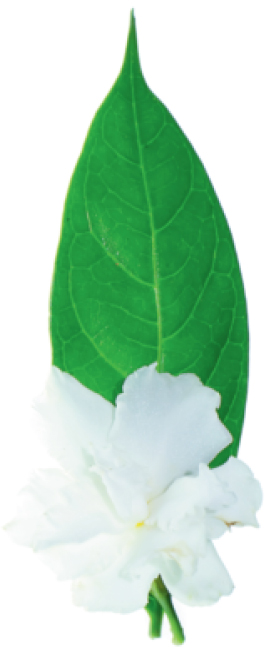
Scent – pungent, honey-rich, curry-like, sweet, restorative, uplifting, tonic, cleansing.
The curry plant (H. italicum, syn. H. angustifolium) is an evergreen aromatic herb, with fine silvery foliage and a mass of small yellow flowers, both of which have a pervasive, sweet curry-like scent – even stronger after rain. The flowers have a papery texture and are used a great deal in dried flower arrangements – several members of the Helichrysum genus are grown as immortelles or everlasting flowers. Although it is a native of southern Europe, the curry plant is hardy enough to withstand most frosts and has become a popular addition to ornamental herb gardens and borders of more northerly countries in recent years.
Reaching a height of 60cm (2ft), the curry plant can make a striking visual impact all year round, especially when its bright silvery leaves are contrasted with darker foliage plants such as rosemary or the blue-leaved rue. It needs to be grown in a sunny position in well-drained soil, for it dislikes cold, wet conditions and will die if the temperature drops below -10°C (14°F). If there is danger of severe frosts, it is worth lifting a plant from the open ground and overwintering it in a cold greenhouse. Like santolina, the curry plant can make an attractive hedge, but it should not be clipped back as vigorously as the former. Nevertheless, it is essential to trim all bushes back in late spring and again after they have flowered to stop them from getting woody and shapeless. The plants grow happily in pots or tubs on a sunny patio. They are best propagated by softwood cuttings in spring or by semi-ripe ones taken in late summer.
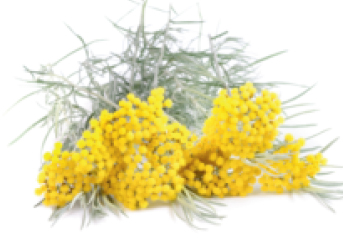
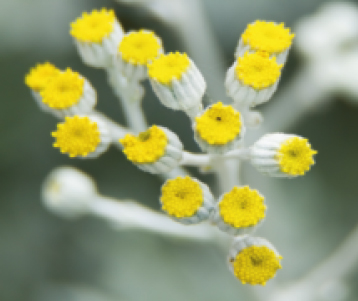
The cultivar H. i. ‘Dartington’ is a compact plant with mustard-yellow button-like flowers; H. i. ‘Nanum’ is a dwarf herb 30cm (12in) high, ideal for knot gardens or edging. H. arenarium is an ornamental species favoured by florists; H. stoechas and H. orientale are both highly aromatic, decorative species that are also used for producing essential oils for the perfumery and flavouring industries.
• Aromatherapy applications – An essential oil is produced by steam distillation from the fresh flowers. In aromatherapy, the oil is used for treating nervous debility and, with massage, for easing muscular aches and pains. The oil also has an antiseptic, cleansing and astringent effect on the skin – see pages 74–6 for making flower water and home skin-care treatments.
• Drying and decorative uses – Many helichrysums are extremely valuable for dried flower arrangements, since they retain their colour and fragrance long after they have been cut. Use dried flower heads in pot pourris, while a spray of fresh curry plant hung in a wardrobe will help deter moths.
• Culinary suggestions – Add a few leaves to egg, vegetable, rice or chicken dishes to give them a mild curry flavour.
• Health-giving properties – In southern Europe, the herb is used mainly for respiratory infections, digestive disorders and skin complaints, usually in the form of an infusion or tea.
Scent – rich, warm, spicy-sweet, hypnotic, slightly narcotic, soporific.
This perennial hardy climber with deciduous, heart-shaped leaves and aromatic greeny-yellow flowers is grown commercially in vast quantities for the production of beer. Male and female flowers or cones are produced on separate plants, and it is the female cones or strobiles that are used for brewing. Although it is not a showy garden plant, it has many endearing characteristics, not least the fact that it is a very quick grower and can cover a trellis or wall in a single season. It is also useful for hiding unsightly spots, to create summer shade over a pergola and for instant ground cover. Thus, the hop is a very versatile plant for the aromatherapy garden, although its rampant nature needs to be kept well in check.
The common hop is an important medicinal plant and has a long history of being grown as a pot herb. Plants need to be adequately supported and require moist but well-drained soil in sun or partial shade. They can eventually reach over 8m (26ft) high. After harvesting the flowers in autumn, the twining stems should be cut right back to stimulate new growth. Hops can be propagated by taking cuttings of young shoot tips from female plants in early spring.
The golden-leaved variety H. lupulus ‘Aureus’ is particularly attractive.
• Aromatherapy applications – The essential oil is used in chypre and fougère type perfumes. In aromatherapy, it is recommended mainly for its profoundly soothing effect. An infused oil for massage as well as a flower water can be produced at home from the dried cones – see pages 74–7.
• Drying and decorative uses – The heady scent of hop flowers on a hot summer's day is unmistakable and in its dried form it is an especially valuable herb for the still room. The dried flowers or cones can be used to make sleep pillows, in bath bags, added to pot pourris or used in dried arrangements. Simply hung from old beams or hooks, the twining stems make attractive household decorations – they also help to dispel unpleasant odours, such as cigarette smoke or cooking smells. Fresh sprays may be used in naturalistic arrangements.
• Culinary suggestions – In spring the young shoots may be eaten raw or cooked like asparagus.
• Health-giving properties – The flowers are still widely used in herbal medicine for their sedative, slightly narcotic, hormonal, bactericidal, digestive, tonic and antispasmodic properties. A herbal tisane can be made at home using the fresh flowers – add honey to taste to produce an excellent night cap.
NOTE
Hop tisanes are not recommended to be taken by those suffering from clinical depression.
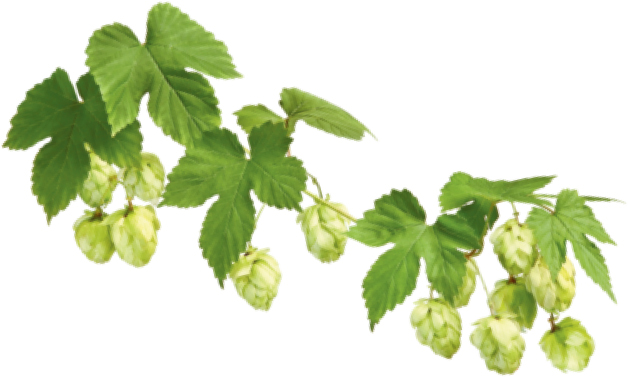
Scent – sweet, mellow, balsamic, rich, floral, heady, narcotic, intoxicating, soothing, sedative, comforting, uplifting.
Hyacinths originated in the south-east Mediterranean, in countries such as Turkey, Syria and Persia. Legend tells how the flowers supposedly grew from the blood of a Greek youth, Hyacinthus, who was killed accidentally by Apollo, and to modern Greeks they denote remembrance. At the end of the eighteenth century, the hyacinth was one of the eight florists’ flowers (see page 25). It is a powerfully perfumed plant producing spires of fragrant waxy flowers in the middle of spring that last for two to three weeks. The different cultivars of H. orientalis range in colour from white, yellow, pink and blue through to red, violet and purple, and are frost hardy. They require well-drained soil and like to be planted in a sunny or semi-shaded position. For impact, they look best clustered in groups. Plant the bulbs in autumn outdoors, using new bulbs each year for the most impressive display. The flowering stem from a new bulb can produce dense flower heads with as many as 60 individual florets. In autumn, bulbs that were planted out the previous season can be moved to less prominent positions in the garden as their flowering is less showy.
Pot-grown plants make a welcome fragrant addition to the Christmas season by forcing them into flower early. Plant in pots the largest bulbs you can find that have been specially treated for forcing in a cool environment. Do this in the early autumn. Place three or four bulbs in a pot filled with fibre or potting mixture, making sure that the bulbs are almost touching each other and that the tops of the bulbs are just showing. To allow the root system to develop, keep the bulbs cool and damp for some weeks: a garage or shed is ideal for this. Once the first shoots appear and the flower spires are a couple of inches high, they can be brought indoors.
Another decorative way to grow hyacinths indoors – a method that was popular in earlier centuries – is to place a bulb in a vase of rain water, allowing the hyacinth to root. The base of the bulb should rest just above the water to avoid rotting. Keep the vase in a dark cupboard until small shoots have formed.
The parent of many cultivars, H. orientalis bears pale mauve fragrant flowers and is closely related to the wild bluebell (Hyacinthoides non-scripta). Highly perfumed cultivars include the striking ‘White Pearl’, exquisitely perfumed ivory-white ‘L‘lnnocence’, which is also grown extensively indoors, and ‘Ben Nevis’, one of the best double white balsamic-scented flowers. Familiar blues include ‘Delft Blue’ and ‘Blue Jacket’, while ‘King of the Blues’ is a magnificent strongly scented variety which is a deep purple-indigo. ‘Amethyst’ is a late-flowering mauve variety.
• Aromatherapy applications – The essential oil (and absolute) of hyacinth flowers are used extensively in perfumery – but today these are often synthetically produced. In aromatherapy, the essential oil is used to treat nervous exhaustion or fatigue, where its soothing, calming properties are useful for combating stress. It is also helpful in overcoming sadness and grief and is used to boost a sense of self-worth.
• Drying and decorative uses – Dried hyacinth flowers can be used in pot pourris. The fresh flowers make very decorative festive displays – see above.
• Domestic use – The bulbs are poisonous, but the white sap is used traditionally as a substitute for starch or glue.
• Health-giving properties – The Greeks described the fragrance of hyacinth as being ‘refreshing and invigorating to a tired mind’. The bulbs are balsamic – that is, soothing, especially to the respiratory system – with some styptic properties (they can halt bleeding), but should not be used at home.
NOTE
Do not use at home as the bulbs are toxic.
Scent – sweet, slightly camphoraceous, warm, spicy-herby, purifying, restorative, refreshing.
Hyssop is a most attractive, highly scented evergreen perennial that comes originally from the Mediterranean and Asia. With its decorative, vivid blue flowers and small lance-shaped leaves, hyssop forms a neat compact bush which is equally at home in a herb garden, rockery or border. Since in its natural habitat it is found on dry, rocky hillsides or on old walls, it will thrive in containers placed on a sheltered patio or on a sunny windowsill – in fact, it needs hot sunshine to really flourish.
Hyssop can also make a neat low hedge or edging plant if it is kept clipped into shape during the growing season. Reaching a maximum of 1m (3ft) high, it flowers continuously throughout the summer and early autumn, especially if it is dead-headed. To maintain a compact shape, trim plants back to 20cm (8in) after flowering (or in spring in cold areas). Hyssop grows easily from seed sown under cover in spring or later directly into the soil once it is warm, or can be propagated by softwood cuttings in early summer. The whole plant is much beloved of butterflies and bees for its strong, aromatic fragrance.
The white hyssop (H. officinalis f. albus) and pink hyssop (H. o. roseus) are similar in height and spread although slightly less hardy than the blue hyssop – they are, however, especially valuable for blending in with specific colour schemes. Rock hyssop (H. o. subsp. aristatus) has darker blue-purple flowers and only reaches a height of 30cm (12in).
• Aromatherapy applications – An essential oil from the leaves and flowering tops of the blue hyssop is used mainly to reduce high blood pressure and ease stress-related conditions through massage. The vaporised oil is especially good for respiratory infections. A home-distilled hyssop water – see page 74 – improves skin tone and can reduce inflammation and discolouration caused by bruises or wounds.

NOTE
Best avoided in pregnancy, by epileptics and by those with high blood pressure.
• Drying and decorative uses – Harvest the flowers when in bud: the dried leaves and flowers can be used in decorative arrangements and pot pourris. Fresh leaves and flowers made into bath bags are good as a pick-me-up for nervous exhaustion.
• Culinary suggestions – Fresh or dried leaves can be used to flavour stews or soups and are good with oily fish, game and fatty meats. Use blue flowers and chopped leaves sparingly in salads.
• Health-giving properties – A tea made from the leaves and flowers of hyssop is one of the best remedies for nasal and lung congestion, sore throats, bronchitis and other respiratory complaints, as it is an excellent antiseptic and antiviral agent. A tonic for the heart and circulation, the tea can also help those suffering from nervous debility and during convalescence.
Scent – bitter, pungent, slightly camphoraceous, stimulating, purifying.
This ancient medicinal herb is a tall, bold perennial that grows to about 1.5m (5ft) high, flowering over midsummer. It has oval, velvety green leaves and large yellow daisylike flowers, a bit similar to a sunflower. It is spectacular planted in a group at the back of a herbaceous border or in a corner of the herb garden, but may look awkward grown as a single specimen. Native to Asia, elecampane is now naturalised across much of Europe and America, having spread through its cultivation as a medicinal herb. In the East particularly it is highly valued as an incense, medicine and spice. It prefers a moist soil and sunny position, although it will tolerate most conditions, and may need staking if unprotected from strong winds. Cut the stems down after flowering and remove the leaves in autumn before they start to look ragged – the whole plant dies down completely over winter. Elecampane is best propagated by taking offsets from the large fleshy rhizomes in early autumn.
I. hookeri is a smaller plant, 75cm (30in) high, with ragged daisy-like flowers; I. magnifica is the giant of the species and can reach more than 1.8m (6ft) high with large dark green leaves; I. ensifolia is a species suitable for American gardens.
• Aromatherapy applications – An essential oil produced by steam distillation of the dried roots is much used in perfumery – it has a soft, woody, honey-like aroma. Unfortunately, the oil from I. helenium can cause a severe allergic skin reaction in some individuals so it is not recommended for aromatherapy use. Sweet inula (I. odora), however, yields an oil that can be used to treat respiratory complaints in the form of an inhalation.
• Drying and decorative uses – The flowers look good in naturalistic arrangements, either fresh or dried. The whole plant dries well, including the roots (see below), which should be lifted in autumn.
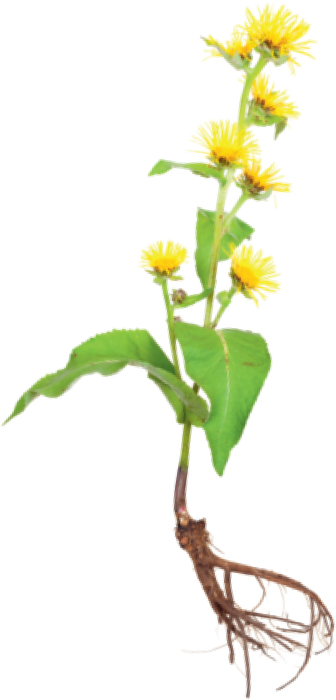
NOTE
Avoid during pregnancy.
• Culinary suggestions – The root of I. helenium can be cooked whole and eaten as a vegetable. It can also be candied or made into cordial.
• Health-giving properties – Elecampane's main use in herbal medicine is as a remedy for respiratory complaints, specifically tuberculosis. A decoction of the root is also used externally for the treatment of persistent skin conditions such as acne, scabies and herpes. A tea made from the sliced root steeped in boiling water is beneficial for soothing dry, irritating coughs and bronchitis.
Scent – flowers: sweet, honey-floral, slightly spicy, uplifting. roots: violet-like, woody, fruity, very tenacious, warming, soothing.
This much-loved flower is one of the oldest cultivated plants – it is depicted on Egyptian temple walls dating from 1500 BC. The Greek word iris means rainbow and refers to the variable nature of the flowers’ colouring: from white, yellow or red through to the deepest purple, violets and blues.
The Iris genus can be subdivided into those species which have a rhizome and those that grow from a bulb. Some species, such as the stately bearded irises, can reach over 1.2m (4ft) tall; others like the petite I. reticulata are only 8cm (3in) high. The Florentine iris is a beardless iris which has dark green sword-shaped leaves, a creeping fleshy rootstock and grows to about 1m (3ft) high. It has delicate, highly scented white flowers tinged with blue and a yellow ‘fall’, that are borne in summer. It is also known as orris because its large rhizomes are used for making orris powder, a very valuable fixative and perfumery material with a distinctive violet-like scent.
Like most iris species, the Florentine iris is a native of southern Europe and prefers to grow in a rich but welldrained sunny position and benefits from having some lime in the soil. It should not be planted too deeply, for it likes the surface of its rhizomes to bake in the sun. It is best propagated by removing offsets in late summer or by seed sown in autumn. The roots should be lifted in early autumn if they are to be used for drying.
The common flag iris (I. germanica) has a rich fruity scent and prefers a moist soil; I. pallida, an ancient white to pale blue species, has vanilla-scented flowers (especially pronounced in the variegated form); I. reticulata is an exquisite miniature purple iris that flowers in winter and has a violet-like fragrance (many cultivars in a range of colours are now available); I. graminea has grassy leaves and small purple flowers with a very strong ‘plum tart’ scent. Then there are the tall bearded irises, many of which have a fine scent.
• Aromatherapy applications – An essential oil and absolute is produced from the dried rhizomes of I. florentina, I. pallida and I. germanica for perfumery use. It is, however, extremely expensive and often adulterated – the oil is also a skin irritant so is not suited to aromatherapy work. The powdered root can be used as a dry shampoo and body powder.
• Drying and decorative uses – The rhizomes develop their violet-like aroma only once they have been dried for more than three years. Use powdered orris to scent sachets, linen, clothes, etc. and as a fixative for pot pourris.
• Culinary suggestions – The dried rhizome has a bitter taste that is used in minute quantities to flavour some liqueurs. The fresh leaves and roots of all irises are harmful if eaten.
• Health-giving properties – In traditional herbal medicine, orris root was used to treat coughs and catarrh. It also has emetic and purgative properties. The blue flag iris (I. versicolor) and I. pallida also have an ancient history of medicinal usage – however, iris species should not be used in home remedies because of their toxicity.
NOTE
Avoid during pregnancy.
Scent – intensely sweet, rich, honey-floral, tea-like, warm, exotic, uplifting, aphrodisiac, narcotic.
Jasmine is undoubtedly one of the most sweetly intoxicating perfumed plants, with a wide range of species, some tender and others hardy. The common jasmine is native to the Himalayas. It is a deciduous or semi-evergreen vine with delicate bright green leaves, bearing hundreds of tiny star-shaped, very fragrant white flowers from summer through to autumn. The scent of the flowers increases at dusk – in India jasmine is known as queen of the night – and it is often planted in courtyards, on verandas or beneath windows where it can be enjoyed in the evening. Despite its fragile appearance, a jasmine vine can climb to more than 10m (33ft) high, and care must be taken if it is grown against a house that it does not lift the roof tiles.
It looks lovely when allowed to scramble over a porch or pergola, its flexible twining stems combining well with clematis, akebia, roses or honeysuckle. Outdoor varieties like full sun and a fertile, well-drained soil; tender species require a minimum temperature of 10°C (50°F). Most species need to be pruned back vigorously after flowering. Propagate plants by semi-ripe cuttings taken in late spring or by seeds sown in early spring.
Other hardy, outdoor jasmines include J. officinale ‘Aureum’ with yellow-variegated leaves; J. x stephanense, a less vigorous climber with pinkish flowers; and the less wellknown J. humile ‘Revolutum’, an evergreen shrub 2.5m (8ft) high, with scented yellow flowers from spring through to autumn. The climber J. mesnyi also has yellow scented flowers and is almost hardy, as is the beautiful evergreen Chinese jasmine (J. polyanthum), which has masses of heavily scented white flowers and is best grown in a cool greenhouse or in a sheltered sunny position. Similar in appearance is the Spanish jasmine (J. grandiflorum ‘De Grasse’), flowering in late summer and autumn, but it is a smaller plant and frost tender. All should be pruned lightly after flowering.
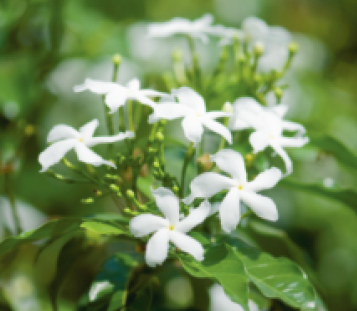
• Aromatherapy applications – An essential oil is produced by steam distillation from the flower absolute. It is very costly to buy, but is priceless as a perfumery material: it has the ability to round off any rough notes and blends with virtually everything. In aromatherapy, the oil is used mainly for sensitive skin conditions and for nervous complaints, especially depression and nervous exhaustion where there is apathy, indifference or listlessness, since the scent helps promote feelings of optimism and confidence. A flower perfume can be made at home – see page 75.
• Drying and decorative uses – In the East, especially in India, fresh flowers are worn in the hair, and made into wreaths and posies at religious festivals.
• Culinary suggestions – Flowers from J. sambac, the tender Arabian jasmine, may be used to flavour tea.
• Health-giving properties – The flowers of J. officinalis are used for their antidepressant and antispasmodic properties, and for their tonic effect on the womb – they strengthen and stimulate the uterus.
Scent – sweet, fresh, warm, green-resinous, woodybalsamic, smoky, purifying, stimulating, restorative.
J. communis is a small evergreen tree that can be found growing wild from the Mediterranean to as far north as the Arctic Circle, in the Soviet Union and Canada. It is a tenacious plant that can thrive on bare rocky mountain slopes, moorland and in cold conditions where few other shrubs survive. It has small flowers and little round berries, which are green in the first year and turn blue-black in the second and third. Only the female tree bears berries. The flowers of the female tree are green and the male, yellow: both male and female plants are necessary for berries to be produced.
Juniper prefers to grow in an exposed, sunny site, but it will tolerate stony, dry or shady conditions in both acid and alkaline soils. It is also very hardy and can survive strong winds, ice and snow, so it is an extremely useful garden shrub for awkward places where little else will grow. Growing up to 6m (20ft) high, with bluish-green narrow, stiff needles, the whole plant exudes a lovely fresh resinous aroma. Although it is possible to propagate a juniper tree from seed, it may take two to three years to germinate. Since they are such slow growers, it is more practical to take semi-hardwood cuttings in late summer – this method also ensures plant gender.
There are a great many cultivars of J. communis, including the Irish juniper ‘Hibernica’, which forms a narrow pointed column up to 5m (16ft) high. ‘Depressa Aurea’ has golden needles and is ideal for ground cover. ‘Prostrata’ reaches only 30cm (1ft) high but has a vast spread of 1.8m (6ft), while the miniature ‘Compressa’ grows only 75cm (30in) high and is ideal for rock gardens or containers. Several other species including J. oxycedrus, J. virginiana and J. sabina are used commercially for essential oil production, mainly for perfumery usage.

NOTE
Avoid using juniper during pregnancy and if there is kidney weakness.
• Aromatherapy applications – An essential oil is produced from the berries, needles and wood of J. communis, although the most highly prized oil is from the berries. It is used therapeutically in skin care for acne, dermatitis, eczema, hair loss, oily complexions, and for conditions where there is an accumulation of toxins, such as arteriosclerosis, cellulitis, obesity and rheumatism. It is also used to combat respiratory infections and to treat nervous tension and stress-related conditions. Make a warming massage oil using the fresh berries – see page 76.
• Drying and decorative uses – Harvest the berries when they turn blue and store in airtight jars. They can be added to pot pourris. Dry the needles for burning as a purifying incense.
• Culinary suggestions – The berries are wonderful used sparingly in marinades, sauces, pickles and when cooking game or poultry – and of course they are famous for flavouring gin. Make a juniper-flavoured vinegar or oil – see page 36.
• Health-giving properties – Juniper has a long history of herbal use, notably as a purification incense. Both the Tibetans and North American Indians burnt sprigs of dried juniper in ritual cleansing ceremonies, while in Europe the burnt twigs were used to combat infectious epidemics and to keep demons at bay.
Scent – strong, spicy-medicinal, clean, fresh, warm, penetrating, purifying.
Bay is a handsome evergreen shrub with glossy, dark green, aromatic leaves and small black berries. In spring, it bears many small yellow tufted flowers, smelling sweetly of honey. As a native of the Mediterranean region, the sweet or true bay thrives in well-drained soil in a sunny position, although it will tolerate some shade. As such, bay can be slightly tender and young bushes may be cut to the ground by a hard frost, although they will usually shoot up again. In cold areas, it is best grown in a tub and brought under glass for the winter. However, in a warm site, sheltered from cold winds, a mature shrub can reach more than 6m (20ft) high with an equal spread if its roots are not confined. New shrubs can be propagated by semi-ripe cuttings in summer or by autumn-sown seeds. A bay tree can make a good structural focal point in a shrubbery or at the back of a herbaceous border. It can also be clipped into all kinds of shapes or trained into a standard specimen by removing the lower shoots of a new plant. Regular clipping throughout the summer months also encourages bushy growth. A clipped bay can make an ideal centerpiece for a formal herb garden, while a pair of standard bay trees grown in large tubs and placed on either side of the front door makes a traditional and dignified statement. Sweet bay is also at home in a warm environment such as a conservatory or greenhouse.
L. nobilis ‘Aurea’, the golden bay, has golden-edged leaves, while L. azorica (syn. L. canariensis) is a rare, more tender species. Several other species are also commonly called bay, including the Californian bay (Umbellularia californica) and the West Indian bay (Pimenta racemosa) or bay rum tree, so called because its essential oil is used to produce the famous hair tonic. The cherry laurel (Prunus laurocerasus) is a useful garden shrub that has a similar leaf to common bay but is poisonous.
• Aromatherapy applications – In aromatherapy, the essential oil is recommended for infections, digestive complaints and muscular aches and pains; in perfumery, the oil is used principally in aftershaves and colognes. An essential oil can be made at home from the fresh leaves, using the distillation method. An infused oil can also be produced for massage purposes – see pages 76.
• Drying and decorative uses – The leaves retain their shape, colour and scent very well upon drying. Harvest in summer for use in dried arrangements of all kinds, including pot pourris. The leaves were once used for strewing floors, especially in churches – the oil and leaves also repel weevils. Sprays of fresh bay last well in water (crush the bottom of the stem first) and look good in large naturalistic arrangements. A wreath made up of fresh bay leaves hung on the front door at New Year is a traditional symbol of protection and courage.
• Culinary suggestions – Dried or fresh bay leaves are essential for any bouquet garni (together with parsley and thyme), especially for flavouring fish, beef, lamb, liver, game and occasionally desserts.
• Health-giving properties – The leaves and berries are used in herbal medicine mainly for their powerful digestive and antiseptic properties. An infusion of the fresh leaves steeped in boiling water can be drunk to stimulate the digestion or can be added to the bath water to soothe aching limbs.
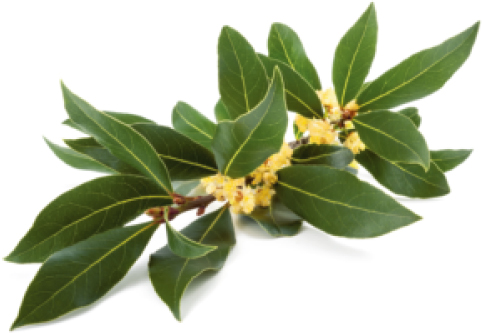
Lavandula angustifolia (syn. L. officinalis)
Scent – sweet, floral-herby, balsamic-green, slightly camphoraceous, soothing, relaxing.
Lavender is both a classical and vital contemporary ingredient in any aromatherapy garden. Its hazy bluishpurple flowers, soft silver foliage and dreamy yet pungent sharp-floral scent seem to capture the very essence of summertime, evoking memories of balmy childhood days and vivid images of the plant's native sun-baked Mediterranean mountains. It is one of the few herbs that has never gone out of fashion and has enjoyed widespread use from the earliest times to the present day.
Lavender is extremely valuable as an ornamental garden plant, as there is now a great range of species to choose from. The so-called true lavender (L. angustifolia) is a relatively hardy, evergreen woody shrub, up to 1m (3ft) tall, with pale green, narrow linear leaves and flowers of a beautiful, violet-blue colour on blunt spikes. The whole plant is highly aromatic and combines well with old rose species and other subshrubs. All lavender species like full sun and well-drained soil, but will tolerate partial shade. The more compact species make good hedging plants for the front of a border or for lining a path. In colder climates, tender species are best grown in terracotta pots that can be moved to the shelter of a greenhouse or conservatory for the winter months.
Cut bushes back after flowering to maintain their shape and prevent them from getting woody (but avoid cutting into the old wood), then trim them again in the spring. Seed can be sown in the spring, but this method does not tend to result in plants that are true to species. Instead take softwood cuttings in spring or semi-ripe cuttings later in summer or early autumn, and keep the young plants protected over winter before planting out the following year.
There are many cultivars of L. angustifolia, notably ‘Alba’ with white flowers and ‘Nana Alba’, a dwarf white; ‘Rosea’ has pink flowers; ‘Hidcote’ is compact with silver leaves and dark purple flowers and ‘Munstead’ has mauve flowers and grows just 35cm (14in) high. Another traditional hardy species is spike lavender (L. latifolia), an aromatic evergreen subshrub up to 1m (3ft) high, broader leaved than true lavender with grey-blue flowers. Less hardy are the French lavender (L. stoechas) with purple bracts and L. s. subsp. pedunculata with magenta-purple bracts; the woolly lavender (L. lanata), which is balsamic-scented with bright purple flowers, and ‘Sawyers’, which is relatively hardy with large blue flowers. The unusual green-flowered lavender (L. viridis) and L. dentata, a winter-flowering variety with finely toothed green leaves, are tender but well worth growing.
• Aromatherapy applications – It is the fresh flowering tops that are used to produce the well-known lavender essential oil, by far the most popular aromatic oil used in aromatherapy and generally regarded as the most versatile essence therapeutically. It is very valuable for skin care and all types of inflamed or infected skin conditions such as acne, allergies, burns, eczema, insect bites and stings. It is also used for muscle and joint problems, respiratory infections, digestive cramps and genito-urinary infections. Its most common use, however, is as a nerve sedative in cases of depression, headaches, hypertension, insomnia, migraine, nervous tension and all stress-related conditions. A traditional lavender water/eau-de-cologne and massage oil can be made from the fresh flowers at home – see pages 74–6.
• Drying and decorative uses – Lavender is also one of the most reliable and versatile herbs of the still room. Harvest the flowers just as they open and hang up to dry in small bunches or lay them out on trays. The dried flowers can then be used in pot pourris, bath sachets and sleep pillows, while the dried twigs make a good burning incense or can be bound together in bundles to scent household drawers and keep moths at bay. See Chapter 5 (page 68) for more ideas for decorative uses.
• Culinary suggestions – Small amounts of the flowers added to vinegars, provençale stews and lamb stuffing impart a bitter-sweet flavour.
• Health-giving properties – Lavender tea is drunk in France for its tonic effect and for its antidepressant, antispasmodic, nervine and sedative properties.
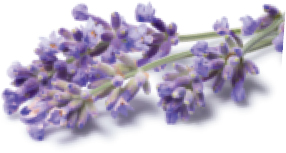
Scent – heavy, honey-like, rich, exotic, floral, sweet, intoxicating, euphoric, aphrodisiac.
The Madonna lily is one of the very earliest exotic garden plants brought to Britain by the Romans. As its name suggests, it is startlingly white with golden stamens and is symbolically associated with the Virgin Mary. The oldest of the cultivated lilies, it originally came from ancient Egypt and Greece and is now an endangered species in the wild.
The bulb produces a rosette of dark green base leaves in autumn, then in spring a flowering stem shoots up to 1.5m (5ft) high with as many as 20 trumpet-shaped flowers that bloom around midsummer. Despite its stately appearance, it is relatively easy to grow, although it can be temperamental, and prefers to have some shade at its the base. It will naturalise in a semi-shaded position, and is equally at home in a border, potager or herb garden, infusing the surrounding air with a heavy honeyed fragrance akin to honeysuckle.
The lilies also make ideal container specimens for a patio or conservatory; the pots can then be moved around so their scent can be enjoyed to the maximum – especially after dark. Plant the bulbs in early autumn with no more than 5cm (2in) of light alkaline soil covering them. Plants can be propagated by seed sown in spring or autumn, or by division of mature bulbs, using the offsets or outer scales, in late summer. The Madonna lily resents disturbance once it has become established.
The golden-rayed lily from Japan (L. auratum), known as the queen of lilies, is easier to grow than the Madonna lily. In the late summer, it carries more flower heads on each stem than any other lily, sometimes as many as 30. This is one of the most outstanding species with an intoxicating, spicy perfume. The regal lily (L. regale), discovered in western China in 1908, is a long-standing favourite with gardeners as well as florists. Equally attractive is L. regale ‘Album’, a pure white version, with a greenish exterior; L. longiflorum is also pure white and makes an excellent easy-to-grow pot plant but requires frost-free conditions. The oriental lilies are a beautiful and highly scented group as a whole, but the creamy cultivar ‘Casa Blanca’ has possibly the most pervasive perfume of all.
• Aromatherapy applications – The fresh flowers of L. candidum are used to produce a costly essential oil used in exclusive perfumery work. L. regale also yields an essential oil used to make an exotic high-quality perfume in Bermuda. Fresh lily flowers can be used at home to make a perfume using the enfleurage method, while the distilled flower water possesses toning and astringent properties. An infused oil of lilies can be used to treat dry eczema and chapped skin as well as making an exotic and sensual massage treatment. See pages 74–6 for instructions on how to make these preparations at home.
• Drying and decorative uses – Fresh lilies are one of the most long-lasting and attractive flowers for indoor arrangements with a pervasive perfume – the scent of some species can be overpowering. Beware of the pollen, which can stain surfaces or clothes.
• Culinary suggestions – Various lilies have edible bulbs, including L. candidum, and are commonly used as vegetables in China and Japan where they are cultivated specifically for food.
• Health-giving properties – The Madonna lily has an ancient history of medicinal usage in both the East and West. The soothing mucilage obtained from the bulbs in late summer is used for irritated skin conditions, including burns, acne, chilblains, ulcers, chapped skin, etc., usually prepared in the form of an ointment.
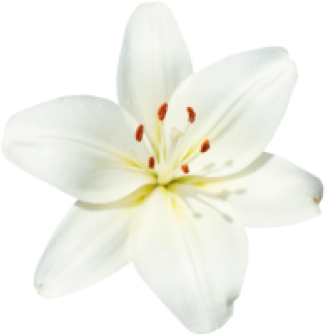
Scent – rich, fruity, slightly spicy, honeysweet, floral, refreshing, uplifting.
The pervasive perfume of honeysuckle is one of the great pleasures of the summer, both in the garden and in the wild. This familiar hedgerow and cottage garden plant is an essential feature in any aromatic garden. The common honeysuckle is a deciduous plant that can reach 6m (20ft) high, bearing its pinky-yellow flowers right through the summer. It is also a very hardy plant (although some species and varieties are tender) and will tolerate most soils, although it likes to be shaded at the base. Most honeysuckles look best when they are left to scramble up walls or trees in a naturalistic fashion, combining well with clematis or climbing roses. They also make good semitransparent screens for dividing up different areas of the garden, climbing up pergolas and for covering unsightly stumps or stone ruins. Most honeysuckles will tolerate being grown in a tub. In autumn, or after flowering, give plants a light pruning or tidying to remove surplus shoots. Propagate them from seed sown in spring or autumn, soft or semi-hardwood cuttings taken in summer or root division in the autumn.
There is a wide range of different species and cultivars that flower at different times of the year, some even in the depths of winter, for example L. fragrantissima. Slightly tender species such as L. etrusca, which grows 4m (13ft) high, make excellent plants for a large conservatory. Other highly scented forms include the Japanese honeysuckle (L. japonica), which is semi-evergreen with creamy-white flowers, and L. j. var. repens, a beautiful tall climber with purplish evergreen leaves.
• Aromatherapy applications – An essential oil from L. periclymenum and L. etrusca is produced in minute quantities for high-class perfumery work, but it is rarely used in aromatherapy. A natural perfume and a skincleansing toilet water can be made at home from the fresh flowers – see pages 74–5.
• Drying and decorative uses – The flexible stems can be used to make dried wreath bases. The wild honeysuckle is suited to naturalistic arrangements – winter honeysuckle is especially valuable for fresh arrangements when other flowers are scarce. Crush the bottom of the woody stem before placing in water; once indoors it releases its spicysweet fragrance. The dried flowers can be used in herb pillows and pot pourris.
• Culinary suggestions – The fresh flowers can be added to salads or infused in apple jelly. The black berries are poisonous.
• Health-giving properties – An infusion of the flowers can be drunk as a tea or as a remedy for coughs, colds and catarrh. Recent research suggests that honeysuckle may be a valuable herb for use in the treatment of colitis.
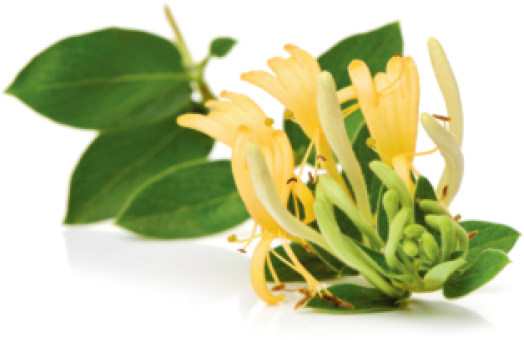
Scent – light, fresh-green, lemony, uplifting, refreshing, restorative.
Lemon balm, as its name indicates, is a delightfully citrus-scented herb, soft and bushy, with bright green, serrated leaves and tiny white or pink flowers. A native of Europe and the Mediterranean region, this herb will thrive in virtually any soil or situation (though it prefers light shade) and can be very invasive if it is not kept in check. Not only does it seed itself readily, it can also spread rapidly by root runners to form new clumps. Unlike mint, however, it is easy to pull up and control, so it is not necessary to keep it confined.
Despite its rampant nature, lemon balm remains a first choice for the herb garden as it is both decorative and useful. Growing up to 1m (3ft) high, the bright foliage of lemon balm looks best when planted next to herbs of a contrasting colour and texture, such as purple sage or the blue-leaved rue. It also grows happily in a container, where it forms a compact shape if it is trimmed regularly. The flowers are very attractive to bees, which explains one of its folk names of bee balm. Planted in orchards or amongst other fruit trees it encourages in bees for rapid pollination. Lemon balm is easy to propagate by root division or by cuttings taking from mature shoots. Cut to ground level after flowering, a new crop of leaves will be produced before the whole plant finally dies back in winter.
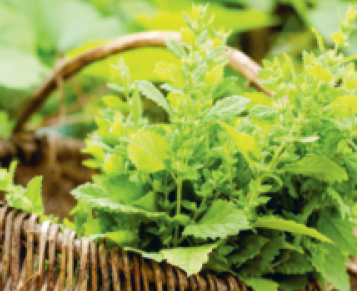
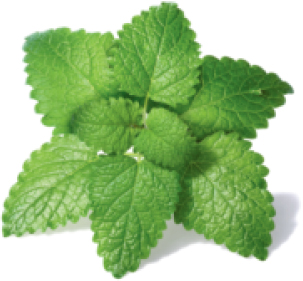
M. officinalis ‘Aurea’ has variegated leaves and is slightly smaller; M. o. ‘All Gold’ has striking golden leaves but is slightly tender.
• Aromatherapy applications – An essential oil is made from the leaves and flowering tops in minute quantities, but most so-called melissa oil, however, contains some or all of the following: lemon, lemongrass or citronella oil. In aromatherapy, the oil is used mainly for nervous conditions, including anxiety, depression, hypertension, insomnia, migraines, shock and vertigo. Melissa is the main ingredient of the traditional eau-de cologne Carmelite water and a toilet water can be made from the fresh leaves – see page 75.
• Drying and decorative uses – Harvest the whole plant as it begins to flower; the leaves retain their colour and scent well for use in pot pourris. Use fresh sprigs in tiny bouquets, known as tussie mussies (see page 78) and the leaves in bath bags, especially those of the eau-de-cologne mint (M. piperita f. citrata) for their refreshing effect.
• Culinary suggestions – Cook with potatoes to add flavour. Make mint sauce to serve with lamb by finely chopping the leaves and adding to vinegar; use young leaves for decorating desserts and in iced drinks. Middle Eastern dishes use lots of chopped fresh mint.
• Health-giving properties – Use the fresh or dried leaves to make a herbal tea for indigestion, nausea, nervous fatigue and respiratory infections such as colds and flu.
Scent – minty, refreshing, invigorating, green-herby, fresh, slightly camphoraceous.
Mint has been cultivated since ancient times and is still one of the most popular and familiar aromatic herbs. Peppermint is a perennial plant up to 1m (3ft) high and dies down over the winter period. White peppermint has soft, green stems and leaves; black peppermint has dark green serrated leaves, purplish stems and reddish-violet flowers. Most mints will quickly take over an area of the garden via their spreading underground runners if they are not confined. Peppermint will thrive in a pot on the terrace or in a window box; it can also be grown in the herb garden by first sinking a container into the soil to ground level, then planting the mint inside. It is easy to propagate new plants from root cuttings at any time during the growing season. Most mints prefer a rich, moist soil in sun or partial shade.
There are many varieties of mint that are grown commercially for the production of essential oils, including water mint (M. aquatica), corn mint (M. canadensis) and pennyroyal (M. pulegium) – all attractive garden varieties. At home, choose the species according to your requirements: apple mint (M. suaveolens) is good for cooking; spearmint (M. spicata) is useful for children used therapeutically; buddleja mint (M. longifolia) is a decorative plant for the border.
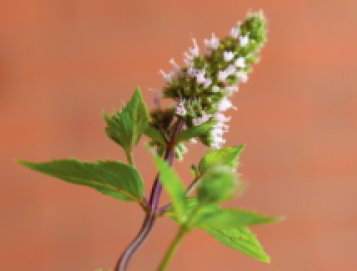
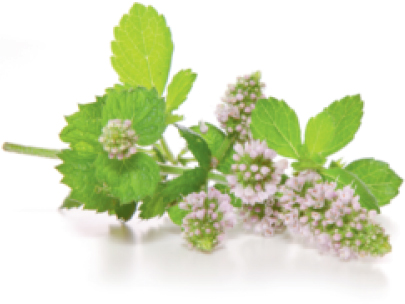
• Aromatherapy applications – In aromatherapy, peppermint oil is mainly used as an insect repellent and as an inhalation for colds, bronchitis and asthma; in perfumery it is employed principally in colognes and toiletries. An eaude- cologne water can be produced at home using young fresh leaves – see page 75.
• Drying and decorative uses – Harvest the whole plant as it begins to flower; the leaves retain their colour and scent well for use in pot pourris. Use fresh sprigs in tiny bouquets, known as tussie mussies (see page 78) and the leaves in bath bags, especially those of the eau-de-cologne mint (M. piperita f. citrata) for their refreshing effect.
• Culinary suggestions – Cook with potatoes to add flavour. Make mint sauce to serve with lamb by finely chopping the leaves and adding to vinegar; use young leaves for decorating desserts and in iced drinks. Middle Eastern dishes use lots of chopped fresh mint.
• Health-giving properties – Use the fresh or dried leaves to make a herbal tea for indigestion, nausea, nervous fatigue and respiratory infections such as colds and flu.
Scent – lemony, sweet, uplifting, minty-fresh, stimulating.
This hardy perennial woodland herb is a native of North America and has become a popular garden flower with numerous cultivars available. The name Monarda honours the Spanish botanist Dr Nicholas Monardes, who wrote a herbal on the flora of America in 1569 and who named the plant bergamot because its scent reminded him of that of the Italian bergamot orange (Citrus bergamia).
Bergamot is a useful herb for planting alongside paths so that it releases its scent when the leaves are brushed. The flamboyant flowers, which are now available in a range of colours from white through pink to scarlet, add interest to the herb garden or herbaceous border over a long period, flowering throughout the summer. The flowers will also attract bees and butterflies to the garden, hence its folk name of bee balm. Although bergamot will tolerate hot sun, it prefers partial shade, requiring a rich, light and moist soil. Sow seed in spring, then thin or plant out to about 45cm (18in) apart in summer. Plants will grow to about 1m (3ft) high. Divide them every three years, or take new root cuttings in spring or softwood cuttings in summer. Seed can be collected for sowing the following year. It is not suitable for growing indoors.

More than five species of bergamot are used for producing essential oils for perfumery work – for eau-de-colognes and hair preparations – including M. didyma, M. citriodora, M. fistulosa, M. clinopodia and M. pectinata.
• Aromatherapy applications – A flower water can be made at home using the fresh leaves and flowers – see page 74. The oil is little used in aromatherapy, despite the fact that it possesses powerful antiseptic properties.
• Drying and decorative uses – Collect whole plants during flowering: the leaves and flowers can then be dried for use in pot pourris, dried flower arrangements and herb teas. The flowers retain their colour well when dried.
• Culinary suggestions – Young leaves can be added to pork stuffing, fruit salads, jams, home-made lemonade and to give tea an Earl Grey flavour. Add fresh flowers to salads.
• Health-giving properties – The wild purple bergamot (M. fistulosa) was used by Native Americans as a remedy for colds and bronchial complaints, while the scarlet bee balm (M. didyma), which grew by the Oswego river, was used to make a digestive tea – thus its folk name Oswego tea. A tea made from the fresh young leaves of M. didyma can be drunk for minor digestive complaints, menstrual pain and nausea.
Scent – clear, fresh, balsamic, green-floral, camphoraceous, sweet-herby, uplifting, clarifying, aphrodisiac.
Myrtle forms a beautiful shrub or small tree up to 3m (10ft) tall, with many tough but slender branches, a brownish-red bark and small evergreen pointed leaves. It has simple, fivepetalled ivory flowers with dense golden stamens, followed by small blue-black berries; and both leaves and flowers are very fragrant.
According to myth, the goddess Aphrodite hid her nakedness behind a sweet myrtle bush and the plant has always been associated with the qualities of beauty, innocence and love. Its name is derived from the Greek myrtos, the ‘herb of love’.
Myrtle is a Mediterranean plant and is almost frost hardy: it can survive outdoors in a warm, sheltered position (covered with horticultural fleece if a hard frost is forecast), but prefers a minimum average temperature, of 5°C (40°F). In colder climates, it is best grown as a conservatory plant or brought under glass for the winter where it makes a lovely specimen shrub, especially as a topiary plant. Trimming back growth in late spring will maintain a pleasing shape. Myrtle is easily propagated by softwood cuttings in spring or hardwood cuttings in mid- or late summer, set in free-draining compost.
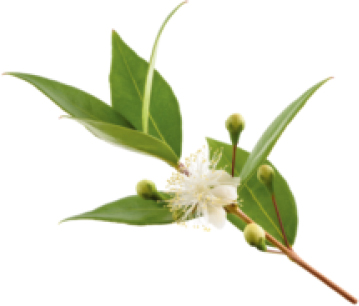
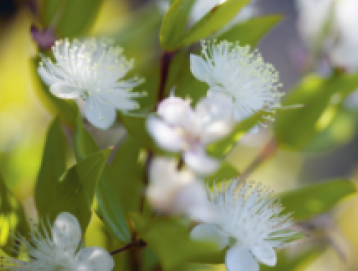
M. communis ‘Variegata’ is slightly smaller than sweet myrtle with variegated leaves; M. c. ‘Flore Pleno’ has long-lasting, fully double white flowers; the dwarf subspecies M. c. subsp. tarentina makes an ideal specimen or container plant.
• Aromatherapy applications – Valued primarily as an antiseptic and skin-care agent, myrtle leaf oil is mainly used for acne, oily skin, asthma, bronchitis, catarrhal conditions, chronic coughs, colds, flu and infectious conditions – especially children's coughs and chest complaints. The fresh leaves and flowers can be used to make a refreshing facial lotion – myrtle is a major ingredient in the classical angel flower water – and a fragrant body oil, traditionally used for beautifying the skin (see page 74 for making flower waters).
• Drying and decorative uses – The berries can be dried and used as a spice, much like juniper. Dried leaves and flowers can also be included in sweet pillows and pot pourris, and hung up in bunches as an insect repellent. The fresh flowers are popular in bridal bouquets, as a symbol of love and chastity.
• Culinary suggestions – Dip fresh leaves in water and lay on the grill when barbecuing meat for 10 minutes to impart a sweet smoky flavour. Preserve the fresh leaves in oil or vinegar for cooking – see page 36.
• Health-giving properties – A tea made from the leaves is said to preserve love and youth – the reason why some French women still drink myrtle tea.
Scent – sweet, heavy, honey-like, floral-green, rich, intoxicating, narcotic, aphrodisiac.
An orchard or meadow full of poet's narcissi is one of the most welcome sights in late spring, each dainty head displaying its star-like, pure white petals which in turn reveal a small yellow inner cup trimmed with red. The name is derived from the Greek term narkao meaning ‘to numb’, due to the plant's paralysing effect on the nervous system. The legend of the handsome Greek youth who fell in love with his own image and was changed into a narcissus flower also tells us something about their intoxicating quality. The scent is certainly very powerful and can even cause headaches if the flowers are present in any quantity in a closed room.
Native to the Middle East and the eastern Mediterranean region, N. poeticus has also become naturalised in southern France and can be found growing wild in the mountains – this is known as des montagnes type, as opposed to the cultivated des plaines variety. The cultivated variety grows to about 50cm (20in) high and has long, narrow sword-like leaves and single flowering stems.
Bulbs should be planted about one and a half times deeper than their size in moist but well-drained soil in early autumn. They are best suited to growing in dappled shade in woodlands, grouped in borders or naturalised in grass, in which case the leaves should not be cut back for at least four weeks after flowering or the next season's show will be diminished. Narcissi are also well adapted for growing in containers: plant them in a double layer for an en masse effect.
There are several types of N. poeticus commonly available: N. p. var. recurvus (pheasant's eye) is smaller with a deeper red eye; ‘Plenus’ is a double version that is very striking. Of other species, N. jonquilla has an orange-like scent and N. tazetta subsp. lacticolor (syn. N. canaliculatus) has a very sweet floral perfume.
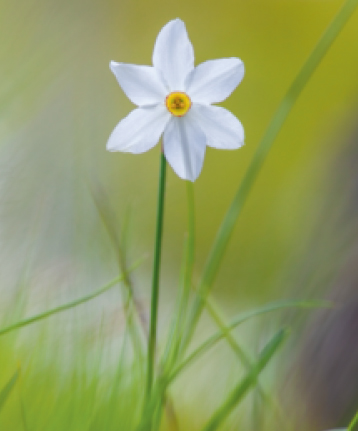
• Aromatherapy applications – Both cultivated and wild species of N. poeticus are used for producing an absolute in France. Jonquil (N. jonquilla) and campernella (N. x odorus) are also used to produce an absolute for perfumery use. In aromatherapy, narcissus oil is used in moderation for its euphoric and inspirational effect. Sensual and hypnotic, it can also be profoundly relaxing. Use flowers to produce an enfleurage-style perfume at home – see page 75.
• Drying and decorative uses – Narcissus make excellent cut flowers on their own – like daffodils, they are best not mixed with other species due to their poisonous sap. Some Tazetta varieties such as the orange-cupped ‘Soleil d’Or’ and the popular paperwhite narcissus (N. papyraceus) can be forced for very early indoor flowering. The latter will flower a month or two after planting and is easy to grow.
• Culinary suggestions – Narcissus bulbs are potentially fatal if eaten: they have a paralysing effect on the nervous system.
• Health-giving properties – Juice from the bulbs was once used by Roman soldiers to numb the pain of battle wounds. The flowers have been used in France for their antispasmodic effects and to treat epilepsy.
Scent – minty, slightly camphoraceous, herby-woody, pungent, mildly narcotic.
Catmint is an attractive, perennial herb: its tumbling grey-green, aromatic foliage and pale mauve flowers add an air of softness to any border. Native to Europe, North Africa and Asia, there are now many species and varieties to be found growing in temperate zones worldwide. Most of the herbaceous, decorative varieties have a loose, spreading habit, making them ideal for planting at the front of borders or alongside paths, especially since the whole plant releases its fragrance when brushed against. The wild species N. cataria has long been cultivated specifically for its medicinal and seasoning properties and is so-called because cats find the scent irresistible and love to roll in the leaves. It grows to about 1m (3ft) high, and flowers over the whole midsummer period. Like most catmints, it is a hardy plant, although rather short-lived, and will tolerate most conditions apart from boggy or very wet conditions.
Ideally catmint prefers a light, well-drained soil in a sunny position, which is why it will also thrive in terracotta pots. Cut plants right back after the first flush of flowers to encourage a second crop of blooms. They can easily be propagated by taking softwood cuttings in spring or early summer, or by dividing an established clump. Sow seed in early spring or late summer.
N. cataria ‘Citriodora’ has light blue flowers and is lemon scented; N. racemosa has decorative purple-blue flowers, grows up to 50cm (20in) high and combines well with old roses; N. x faassenii has loose spikes of lavender-blue flowers and grows up to 45cm (18in) high. The stunning cultivar ‘Six Hills Giant’ has deeper purple flowers and grows to 1m (3ft) high. Calamintha officinalis, also known as catmint, is mainly used to produce nepeta oil commercially.
NOTE
Avoid using catmint during pregnancy.
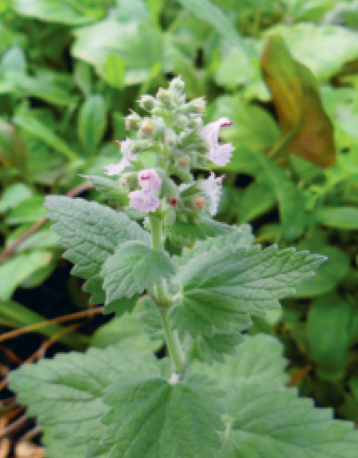
• Aromatherapy applications – The leaf oil is occasionally used for stress-related conditions, digestive complaints and muscular aches and pains. A flower water can be made at home from the fresh leaves – see page 74.
• Drying and decorative uses – The leaves of N. racemosa retain their lemony scent especially well when dried and may be used together with lemon balm and verbena to make delightfully fresh-scented pot pourris or bath bags. The flowers of all nepetas will add a soft colour to arrangements, either fresh or dried.
• Culinary suggestions – Add freshly picked young shoots of N. cataria to salads or use them to give meat a minty flavour.
• Health-giving properties – the leaves of N. cataria are still used in herbal medicine for digestive and nervous complaints, and as a specific remedy for colic in children and for the common cold. An infusion of the fresh leaves steeped in boiling water makes a delicious tonic tea or can be used as a traditional cold remedy. Served cold with ice, it also makes a refreshing summer drink.
Scent – light, fresh, sweet-spicy, balsamic, clove-like, uplifting, purifying, reviving, warming.
Basil is one of the most valued aromatic herbs and there are some 160 different varieties found worldwide. Native to India, the richly balsamic-scented species known as holy basil (O. sanctum) is held sacred by Hindus and frequently grown outside their temples for its protective influence, but it is not used in cooking. When other types of basil later spread throughout the Mediterranean region it became used extensively as a culinary herb, especially in Italy. Sweet or French basil (O. basilicum) is a tender annual herb with green, shiny ovate leaves, up to 60cm (2ft) high bearing spikes of two-lipped greenish or pinky-white flowers throughout the summer. It is perhaps the best variety for general culinary and therapeutic usage – both its leaves and flowers emitting a warm, powerful clove-like scent. It is best planted in a warm, sunny, sheltered site in well-drained, rich soil after all danger of frost has passed.
Basil makes a good companion plant in the vegetable garden, especially alongside tomatoes. Most basil species will also thrive grown in pots on a sunny windowsill or in a cool greenhouse, where they can be treated as short-lived perennials. Keep pots moist but not waterlogged. Sow seed thinly in late spring as soon as the soil has warmed up – it dislikes being transplanted. Always protect plants from scorching sun and pinch out tops to encourage bushy growth.
Bush basil (O. minimum) is slightly hardier and more compact in shape than sweet basil; it has smaller leaves and is well suited to growing on a windowsill. The pink flowers and purple leaves of O. basilicum ‘Dark Opal’ and ‘Purple Ruffles’ contrast well with the bright green leaves of sweet basil, combined in a hanging basket or as a feature in the herb garden. O. x citriodorum is a tender, small variety with lemon-scented, bright yellowish-green leaves, valuable in the kitchen and still room.
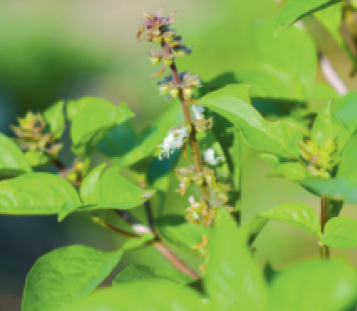
NOTE
Avoid basil tea during pregnancy.
• Aromatherapy applications – Basil oil is mainly used for muscular aches and pains, cramp, rheumatism, and respiratory and infectious diseases. In addition, basil is one of the best aromatic nerve tonics for conditions such as anxiety, depression, insomnia, migraine and nervous tension. The scent alone can help to clear the head, relieve intellectual fatigue and give the mind greater clarity. An infused oil for massage can be prepared from the fresh leaves – see page 76.
• Drying and decorative uses – Fresh pots of basil grown in the kitchen look decorative and will help keep flies away. Dried basil leaves and flowers can be used in pot pourris.
• Culinary suggestions – The leaves are best picked fresh for cooking. Add them at the very last minute since they can become bitter if they are cooked for a long time. Leaves should always be picked from the top to prevent the plant flowering and then torn rather than chopped. They can be used in all sorts of dishes, especially pasta, egg, chicken or shellfish recipes, combining delightfully well with garlic, tomatoes or aubergines. They can also be added to soups, salads and sauces to give a fresh, tangy flavour or to make flavoured oils and vinegars – see page 36.
• Health-giving properties – A tonic tea made from fresh basil leaves aids indigestion, nausea and mild digestive upsets.
Scent – warm, woody, spicy-camphoraceous, herby, stimulating, refreshing.
There is much confusion surrounding the naming and identification of the various members of the oregano and marjoram family for they are closely related. To confuse matters still further, common oregano, which is also known as wild marjoram, is very variable in scent and appearance according to where it is growing. Generally speaking, wild marjoram (O. vulgare) is a bushy perennial herb, 45cm (18in) high, with upright purplish stems and oval leaves that are sometimes flushed with red, and dark purple-pink flowers. The whole plant is highly aromatic, with a warm, sweetly spicy flavour. O. vulgare is found growing wild from Europe to right across to central Asia and thrives in the warm Mediterranean region – where it is called oregano or joy of the mountains. In Britain, the same plant has paler pink flowers and the scent is less pronounced.
With the exception of sweet marjoram (O. majorana), most oregano species are hardy and will tolerate a range of situations, as long as the soil is not waterlogged. Softwood cuttings taken in spring best propagate plants or do it by root division after the plants have flowered. Trim the plants back after flowering to maintain their shape.
There are numerous cultivars of O. vulgare, including the lovely golden-leaved marjoram O. v. ‘Aureum’, which adds luster to any herb garden with its bright, fresh foliage. It forms a compact low-growing mound and has a mass of mauve flowers. ‘Aureum Crissum’ also has golden-green leaves which are slightly crinkled; ‘Compactor’ is a dwarf form with pink-violet flowers; O. v. var. album is a bushy, white-flowered naturally occurring variety; while ‘Olyphant’ has white-variegated foliage and is good for containers and edging. The most highly scented marjoram, however, is the pot marjoram (O. onites), which has erect stems bearing white to pink flowers and very aromatic leaves. The ‘knotted’ sweet marjoram (O. majorana) is a slightly tender bushy perennial plant (cultivated as an annual in colder climates), up to 30cm (12in) high with hairy stems, green-grey oval leaves and small pinky-white flowers in clusters or knots produced in late summer. It is perhaps the best species for culinary purposes, having a delicate, more refined flavor and scent. For similar reasons, it is also the favoured species used in aromatherapy and perfumery work. Spanish oregano or cone head thyme (Thymus capitatus) is a perennial creeping herb with a woody stem, small dark green leaves and pink or white flowers borne in clusters. Although this herb is strictly thyme, it serves as the source for most so-called oregano oil.
• Aromatherapy applications – An essential oil is produced by steam distillation of the dried flowering herb. Used in massage, wild marjoram oil helps relieve aching joints, stiffness, rheumatism, sprains and strains. It is also used to help combat respiratory infections and digestive complaints. Sweet marjoram oil, which has a more sedative effect, is used for headaches, hypertension, nervous tension and stress-related conditions. A massage oil can be made at home from the fresh herb – see page 76.
• Drying and decorative uses – Infused in vinegar, wild marjoram was earlier used as a substitute for smelling salts; in baths, the fresh flowering tips are reviving and uplifting. The leaves and flowers of sweet marjoram also dry well and are good for cooking. The decorative marjoram species can be used in dried flower arrangements, wreaths, pot pourris, etc.
• Culinary suggestions – Both marjoram and oregano are used extensively in cooking – they are one of the ingredients of bouquet garni – particularly in tomato-based or Italian dishes.
• Health-giving properties – Both marjoram and oregano have powerful antiseptic properties and were much favoured by early herbalists such as Culpeper and Turner. They also have powerful antiviral and tonic properties: a tea made from sweet marjoram leaves helps combat colds and infections; marjoram leaves, chewed, can relieve toothache.
NOTE
Not to be used during pregnancy.
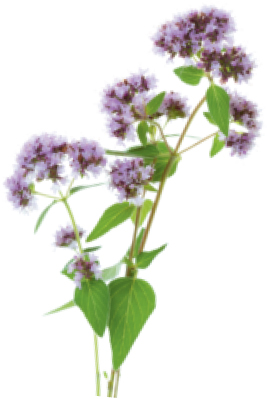
Scent – sweet, rosy, floral, slightly green, minty, harmonising, balancing, uplifting, refreshing.
Pelargoniums are some of the most obliging tender plants, needing little watering and protection in winter, and a bare minimum temperature of 1–5°C (34–41°F). They are equally happy in a cool conservatory or in a warm house provided they have enough light. They do not, however, like hot moist conditions. Generally it is the leaves that are scented rather than the flowers, although there are exceptions such as P. gibbosum and P. triste, whose flowers are sweetly scented in the evening. Pelargonium is a large genus of shrub-like perennials, mostly flowering in the summer and sometimes into the autumn, although they are often cultivated as annuals. Besides the scented-leaved species, there are four other categories within the genus.
The scented-leaved varieties originally came from the Cape Province in South Africa, but the genus is also native to the Mediterranean and the Middle East. In England they were first grown by the rich in glasshouses and it was only in the nineteenth century that they gained wider popularity and were grown in pots on cottage windowsills.
The great number of scented pelargonium varieties available has ensured their widespread popularity. Pelargoniums are now frequently planted in pots and are a colourful addition to hanging baskets and window boxes. They are also popular bedding plants in the border: if planted outside, they like lots of sunshine and a well-drained soil. Beware of overwatering, especially in winter, when the plants should be kept dryish. To propagate, take softwood cuttings from mid-spring right through to late summer.
It is important to differentiate between pelargoniums and geraniums, as they are frequently confused. The original wild pelargonium from South Africa had small leaves and flowers but most we know today are hybrids – all need minimum winter protection. Geraniums, by contrast, are hardy perennials. Both, however, belong to the same family, Geraniaceae. One of the best scented pelargoniums is P. graveolens, a large variety with pink starry flowers and rose-scented leaves; it can grow to 1m (3ft) feet high. ‘Lady Plymouth’ is a green and cream variegated variety with a delightful rose scent. Another excellent rose-scented species, bearing pale pink flowers, native to South Africa is P. capitatum, while the fragrance of the tiny ‘Attar of Roses’ is similar to the more expensive true attar of roses and is sometimes used as a substitute. More of a balsamic fragrance is found in P. Fragrans Group ‘Creamy Nutmeg’, which has a musky scent similar to nutmeg; another balsamic-scented variety is the oak-leaf pelargonium (P. quercifolium). The showy rose-pink ‘Clorinda’ is eucalyptusscented with a touch of rose; P. tomentosum, a tall variety with a minty scent, was a favourite of Gertrude Jekyll and used by her to make peppermint jelly. An old variety of pelargonium with a definite nutmeg scent is ‘Lady Mary’, while ‘Pretty Polly’ and ‘Little Gem’ are almond scented. Lemon scented-leaved pelargoniums include P. crispum ‘Variegatum’, the Prince Rupert geranium, P. c. ‘Major’ and P. ‘Citriodorum’, while P. ‘Prince of Orange’ has leaves sweetly scented with oranges. P. odoratissimum is apple scented and is sometimes used to flavour apple jelly.
• Aromatherapy applications – An essential oil is extracted from P. graveolens by steam distillation of the flowers and leaves. It has antifungal, antiseptic and astringent properties, and is much used in skin care and for the treatment of cellulitis and water retention. It is also used to treat sore throat and tonsillitis, poor circulation, menopausal problems and stress-related conditions. A flower water can be made at home from the scented leaves – see page 74.
• Drying and decorative uses – Dried leaves are used in pot pourris. Scented-leaf pelargoniums are perhaps some of the most pleasing insect-repellent plants.
• Culinary suggestions – Leaves of P. graveolens can be made into a refreshing tea but avoid the lemon-scented varieties of P. crispum, as these can act as an irritant. The leaves can also be used to flavour fruit syrups, preserves, and alcoholic and soft drinks.
• Health-giving properties – Various pelargonium and geranium species, such as Geranium robertianum, have been used since antiquity for their medicinal applications, mainly for their styptic, tonic and antiseptic properties.
Scent – aromatic, minty-green, slightly camphoraceous, stimulating, uplifting, fresh, astringent.
Mint bushes are evergreen shrubs native to Australasia. Both the leaves and flowers, which are carried in late spring or early summer, are aromatic although the leaves are not always mint-scented. Some species can grow to more than 4m (13ft) tall and most are relatively hardy, although some require a minimum winter temperature of 5°C (41°F). It is best to plant them in full sunshine against a protected wall in fertile, well-drained acid or neutral rich soil – the bushes do not grow well in chalk. The dark green leaves of the hardy P. cuneata smell strongly of wintergreen and its scented white or lilac orchid-like flowers are marked with purple. This species grows only about 1 m (3ft) tall and can make an attractive feature as a patio plant or as a low evergreen hedge. Its attractive foliage, compact form and mass of scented long-lasting flowers, make it a valuable addition to a herbaceous border or rockery.
More tender species can be grown in containers in a conservatory and moved outside into full sunshine during the summer months. Propagate mint bushes by semiripe cuttings in autumn, or by seed sown in spring then protected under glass. Prune very lightly after flowering to maintain a compact shape. Take care not to over-water as this can kill young plants.
The thickly clustered fragrant violet flowers of P. melissifolia are most decorative and striking, as are those of the round-leaved mint bush (P. rotundifolia rosea) which carries lavender-purple flowers in early spring – the latter can reach a height of 4m (13ft) in its native country. The leaves of both these bushes are powerfully mint-scented. P. rotundifolia needs to be planted in peaty compost in a frost-free environment or have winter protection in a greenhouse or conservatory, as does the tender P. ovalifolia.
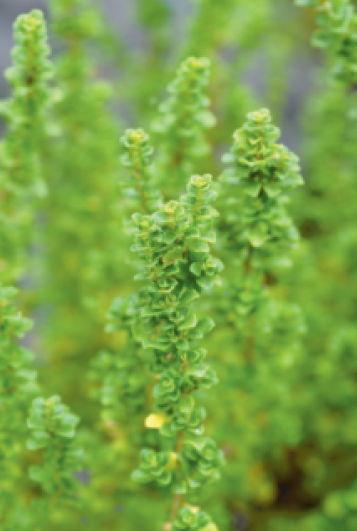
• Aromatherapy applications – The essential oil extracted by steam distillation from the leaves is rich in menthol and cineole – much like peppermint oil – but is seldom available for use in aromatherapy practice.
• Drying and decorative uses – Use fresh sprays in posies. Dry the leaves and flowers for burning on an open fire – the dried leaves can also be used to liven up pot pourris.
• Culinary suggestions – The leaves can be brewed to make a minty refreshing tea.
• Health-giving properties – Several species were used by Australian Aborigines to combat headaches and infections. The infused leaves have antibacterial and fungicidal properties and can be used to relieve the common cold or a congested head, either drunk as tea or as a steam inhalation.
Scent – floral, sweet, spicy, raspberry-scented, violet-like, healing, pungent, powerful.
The genus Reseda, native to the Mediterranean and North Africa, includes hardy and half-hardy fragrant annuals and biennials. R. odorata is an annual. In Roman times, the plant reputedly had healing and protective properties: reseda means ‘to heal’. By contrast, in Egypt it grew so freely and was so undistinguished that it was considered a weed. Mignonette, however, was much loved by the Empress Josephine, who was sent the seeds by Napoleon during his campaign in Egypt. It subsequently became very fashionable, especially planted in pots on Parisian balconies – its popular name mignonette signifies ‘little darling’. The plant was introduced into England at the beginning of the eighteenth century, when its powerful perfume was used to disguise unpleasant street smells. Legend holds that if a lover rolls three times in mignonette, good fortune will follow. Although the plant has fallen out of fashion, it is well worth growing for its delightful sweet perfume if not for the success of aspirant lovers. Seed should be sown under glass in spring, then plant out the young seedlings in a border that enjoys full sunshine, in fertile well-drained soil. The flowers themselves, although fragrant, are not overly attractive, being somewhat straggly. But what they lack in appearance, they make up for with their very intensely powerful perfume, which is greatly attractive to bees. Deadhead plants regularly for maximum flower production.
The best and most fragrant of the mignonettes is R. odorata (although other cultivars have been developed). Its semi-star-shaped greenish-white flowers, borne throughout summer into early autumn, are deeply perfumed with a raspberry scent, pervasive throughout the day into the evening. It grows up to 60cm (2ft) tall.
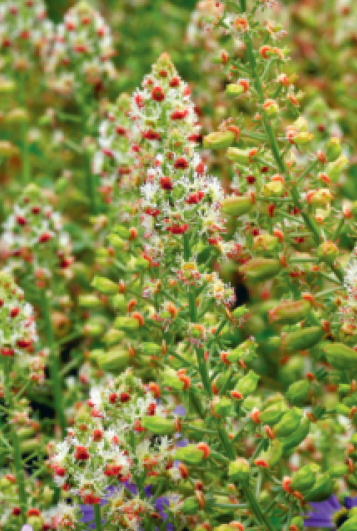
• Aromatherapy applications – The powerfully scented essential oil of mignonette is very expensive and used only in small amounts in perfumery. The oil is not employed for aromatherapy use.
• Drying and decorative uses – The flowers of mignonette can be dried and used in pot pourris.
• Culinary suggestions – Not recommended for culinary use.
• Health-giving properties – The leaves were used by the Romans to treat bruising.
Scent – clove-like, fruity-spicy, musky, exotic, warming, uplifting, restorative.
The genus Ribes comprises about 60 species of shrubs, including many cultivated varieties of currants and gooseberries. R. odoratum, otherwise known as R. aureum, and popularly as the buffalo, golden or clove currant, carries spicy, clove-scented golden flowers in arching clusters in the spring. The cultivar ‘Crandall’ is especially beautiful: in autumn the leaves are flushed with warm tints and the flowers transform into large yellow fruits. A native of North America, its name buffalo currant derives from the North American use of the berries, which were ground to flavour buffalo meat and make meat patties. It is a hardy deciduous shrub growing 1.8–2.5m (6–8ft) high and prefers full sunshine or very light shade in fertile well-drained soil, although it is tolerant of most soils. Propagate the shrub by taking hardwood cuttings in the winter. As flowers are carried on the previous season's growth, prune the older shoots after flowering; in winter or early spring, cut any straggling stems right down to ground level. This will promote better growth.
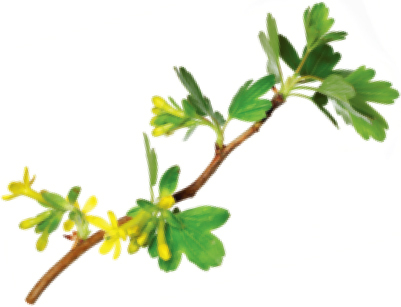
Not all currants are deciduous; some are evergreen, such as R. laurifolium, which is native to China. Its leaves are a deep green, similar to laurel, and its subtle sweetly scented, greenish-yellow flowers are borne in late winter and early spring. R. viburnifolium is another evergreen species, native to California and thus requiring a certain amount of winter protection. Try planting it against a warm wall. In spring it has lovely terracotta blossoms and its evergreen leaves have a fragrant pine aroma when crushed. R. gayanum, evergreen and native to South America, also requires some winter protection but has the advantage of blooming in early summer with softly fragrant, pale yellow flowers. The best known of the flowering currants, R. sanguineum, with its rose-red flowers, has a rather unpleasant musty scent and is not really recommended for its fragrance. The familiar blackcurrant bush (R. nigrum) is the medicinal species and is used to produce an essential oil.
• Aromatherapy applications – An exotically scented absolute known as cassis and an essential oil (niribine oil) are derived from the fresh buds of the blackcurrant bush (R. nigrum). It is an expensive oil used in high-quality perfumery, but is little employed in aromatherapy practice.
• Drying and decorative uses – The flowering sprays of ornamental Ribes species can be used in fresh flower arrangements, but it is recommended that the tough stems are re-cut and sliced before putting them into water. Recutting will increase their absorption properties.
• Culinary suggestions – Blackcurrants are used for jammaking and in tarts. They can also be steeped in brandy for a tonifying winter liqueur! Redcurrant jelly complements game or lamb and the fruit can be used in puddings, along with blackcurrants. Delicious homemade wine can also be made from both red- and blackcurrants.
• Health-giving properties – Blackcurrants are high in vitamin C: boil redcurrants or blackcurrants with honey to obtain a soothing syrup for sore throats. Blackcurrant tea is good for colds and urinary infections, as well as helping to lower blood pressure and strengthen capillaries. An infusion of blackcurrant can also relieve nervous tension. The young tender leaves of the blackcurrant are astringent and can be dried for use as tea on their own or blended with Indian teas.
Rosa gallica (plus R. damascena and R. centifolia)
Scent – rich, deep, sweet-floral, slightly spicy, tenacious, soothing, uplifting, aphrodisiac, warming, euphoric.
Ancient Persia is thought to be the birthplace of the cultivated rose and the first country where roses were planted in formal gardens. Botanically speaking, however, it is difficult to locate the exact origin of the first wild roses because early records are far from complete. What is clear, is that from very early times there existed several distinct species of rose that were distributed over the northern hemisphere, having two main centres – one in Central Asia and the other in Western Europe. These became known as old roses, because they formed the basis of all the subsequent hybrids or new roses. The division between old and new roses is generally taken to be 1800, largely due to the influence of the Empress Josephine, a passionate rose grower. Since then many new varieties have been developed and today there are numerous books available on the cultivation of garden roses, illustrating the diversity, beauty and allure of the modern (but often scentless) new rose. In recent years, however, there has a been a nostalgic return to the appeal of the old scented rose varieties, largely through the efforts of David Austin, Peter Beales and Graham Stuart Thomas in England.
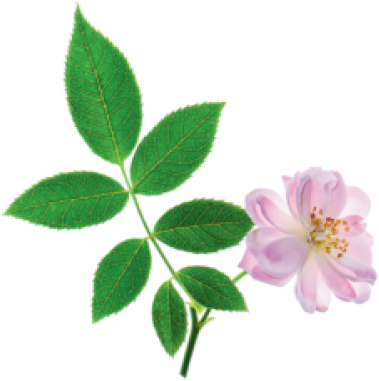
Damask rose
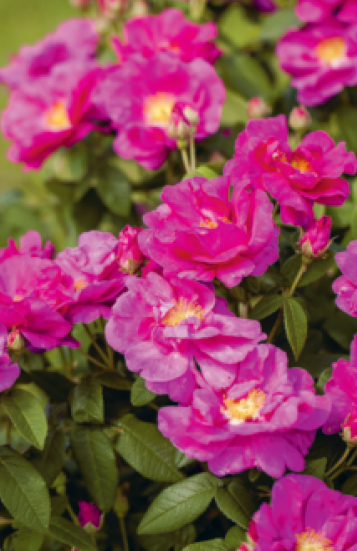
Gallica rose
The most significant of the original highly scented old roses, especially with regard to the production of essential oils, are the following: the Gallica rose (Rosa gallica, syn. R. rubra); the Damask rose (R. damascena); and the Cabbage rose (R. centifolia). See Chapter 3 for more information.
Cultivars of the Gallica rose, such as ‘Belle de Crecy’, are still used today for the production of essential oils. The Damask rose (R. damascena) is still used to produce a very highquality essential oil known as attar of roses, and an absolute, mainly for use in perfumery. The Cabbage rose or hundredleaved rose produces a rich, sweet-scented oil or absolute for which it is widely cultivated in Turkey and North Africa (Morocco and Tunisia). It has given rise to innumerable other subspecies, including the Moss rose. All these roses prefer an open, sunny position with shelter from strong winds and a loamy, rich soil. Most roses can be propagated by hardwood cuttings taken in autumn. Prune in spring and dead-head regularly to encourage a long flowering period.
Other ancient highly scented varieties which are still used for the production of essential oils but on a smaller scale include the dog rose (R. canina), a deciduous, rambling shrub which can reach 3m (10ft), bearing delicate pink or white, single five-petalled flowers. Sweet briar (R. rubiginosa) has lovely apple-scented leaves. The musk rose (R. moschata) is a snow-white rose, with a very fragrant scent; it grows into a vigorous bushy shrub, and is often planted as a windbreak or hedge. Tea roses are generally either climbers or small, sparse bushes bearing a continuous succession of large, beautiful flowers in shades of pink, buff or light yellow. The essential oil of the Oriental or Tea rose is mainly produced in the East, where it is used as a perfume and remedy.
• Aromatherapy applications – An essential oil, otto or attar, is produced by water or steam distillation from the fresh petals of various types of rose (see above). A concrete (solid perfumed wax) and absolute (viscous liquid) are also made by solvent extraction from the fresh petals – the Bulgarian absolute (R. damascena) is considered superior for perfumery work, but in therapeutic practice rose maroc oil (R. centifolia) is more commonly used, having a pronounced euphoric and heart-warming effect. Rose oil and rosewater are also used extensively in skin care for broken capillaries, mature and sensitive complexions, and wrinkles; to help regulate the menstrual cycle; and more generally for stress-related complaints, such as anxiety, depression, impotence, insomnia, frigidity and headaches. To make your own rose water see page 74.
• Drying and decorative uses – Fresh roses are indispensable for all kinds of flower arrangements; dried rose buds and rose petals are the main classical ingredients for pot pourris. Rosewater has traditionally been used to perfume a range of household items such as linen, paper, clothes, etc.
• Culinary suggestions – Petals of the apothecary's rose (R. gallica var. officinalis) can be added to salads, exotic chicken and rice dishes, or used in jam-making.
• Health-giving properties – In early times, the petals of the apothecary's rose were often made into a fragrant powder and employed for their pharmaceutical properties. The leaves, but especially the hips, of the common dog rose (R. canina) were also once a common European folk remedy – the hips can be made into a syrup or tea at home which is very rich in vitamin C.

Cabbage rose
Scent – pungent, fresh, pine-like, herby, woodybalsamic, slightly camphoraceous, stimulating, restorative, purifying.
Rosemary has been called the prince of aromatic herbs. It is one of the most deliciously fragrant plants for the kitchen or herb garden and a popular aromatic shrub for a traditional mixed border. Gertrude Jekyll wrote in House and Garden:
. . .ever blessed rosemary all over the garden, so that every few steps the passer-by can run his hand over the blue-flowered branch lets and smell the warm resinous incense in his palm.
This handsome evergreen bush has silvery-green needleshaped leaves and pale blue scented flowers in late spring, and the whole plant is strongly aromatic. Rosemary has been much loved by gardeners throughout the ages. Historically, its pungent scent has been associated with the qualities of faithfulness and fidelity, as Shakespeare noted: ‘There's rosemary, that's for remembrance’. It has also been used traditionally as an aid to memory or mental alertness.
Rosemary also has a very ancient history of medicinal usage. It was burned in early religious ceremonies to purify the air and its powerful anti-infectious qualities were employed during the plagues of Europe to ward off illness. Of all the different rosemary varieties available, R. officinalis is still considered to be the most valuable species, medicinally and for culinary use. The native habitat of the wild rosemary is Asia Minor and southern Europe and, like lavender, it thrives in the Mediterranean region. Given the right warmth and protection, it can grow up to 1.8m (6ft) high, but in more northerly climes it rarely grows taller than 1.2m (4ft). Rosemary can be slightly frost tender and is best grown in a sunny position, beneath the shelter of a wall if possible, in well-drained soil. In a protected situation it can be grown as a hedge or topiary specimen, but needs to be trimmed regularly to promote bushy growth and to retain its shape. In fact all rosemary plants benefit from being clipped back, but avoid doing this in autumn or they may be killed by frost. Rosemary also looks good grown in pots or tubs, although it will not tolerate waterlogged conditions so it is vital to ensure good drainage. Growing rosemary from seed takes some skill: it is much easier and more reliable to propagate from either softwood cuttings taken in spring, or semi-hardwood cuttings in summer.
There are many beautiful cultivars available to the gardener today. The flowers can range in colour from bright blue, mauve-purple, pink and greyish-blue to white, while the needle-like leaves can vary from a rich, dark green to a variegated, silver or golden form. R. officinalis var. albiflorus has white flowers; ‘Primley Blue’, ‘Tuscan Blue’ and ‘Miss Jessopp's Upright’ (a tall variety) have mauve-blue flowers and a dense upright habit, making them good hedging plants. Several cultivars have a trailing or arching habit, including ‘Severn Sea’ (with brilliant blue flowers), ‘Majorca Pink’ and prostrate rosemary (R. o. Prostatus Group) – good for edging, on walls or in pots.
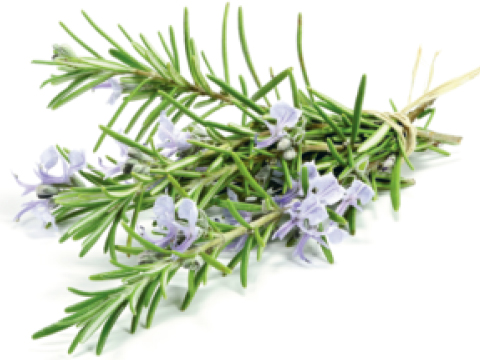
NOTE
Avoid this herb during pregnancy. Not to be used by epileptics.
• Aromatherapy applications – A very popular essential oil is produced by steam distillation from the fresh flowering tops. In aromatherapy, it is invaluable in its capacity to raise the spirits and is used to treat listlessness, mental fatigue and nervous exhaustion. Used in combination with massage, it is employed in the treatment of arteriosclerosis, muscular pain, poor circulation and rheumatism; as an inhalation, it is highly efficient at combating colds, bronchitis, flu, and other infections. It is also highly effective for infected skin conditions and as a hair-conditioning agent for it is antiseptic, promotes hair growth and regulates seborrhoea. Famous as the main ingredient in Hungary water, a youth-promoting elixir, and in eau de cologne, the water distilled from the seed or flowers also sweetens the breath. See pages 74–6 for instructions on how to make distilled rosemary water and oils for massage.
• Drying and decorative uses – As rosemary is an evergreen, it can be harvested throughout the year for decorative use in bouquets or tussie mussies (see page 78). It is an indispensable ingredient of pot pourris, retaining its scent and colour well on drying. The dried twigs can be burnt on barbecues or open fires for a lovely incense-like aroma; a bunch of the fresh needles in a bath sachet gives a wonderful uplifting scent; use infused rosemary water as a final rinse for dark hair.
• Culinary suggestions – In the kitchen this strongflavoured, sturdy herb is often used with lamb but is also delicious with roast chicken, fish, casseroles and tomato dishes, plus rice, roast potatoes and salads, using discretion. Rosemary is good for flavouring oils and vinegars (see pages 36).
• Health-giving properties – Medicinally rosemary has been used to treat a wide range of complaints, mainly due to its outstanding antispasmodic, anti-infectious and tonic qualities. Rosemary tea made from the fresh flowering tips may be used as a gargle for mouth and throat infections and can be drunk as a general tonic, especially for the nerves and circulation.
Scent – bitter, pungent, herby-fruity, sharp, acrid, green, stimulating, purifying, warming.
Garden rue, which is also known as herb of grace, is an extremely ornamental evergreen herb with fine bluishgreen, deeply cut leaves and a pungent, bitter scent. It has a woody stem and small greenish-yellow flowers borne in late summer, and forms a bushy shrub up to 60cm (2ft) high. It was a favourite remedy of the early herbalists, especially as an antidote to poison, and together with southernwood (Artemisia abrotanum), was once placed in courtrooms to keep jail fever at bay. It is often grown in traditional herb gardens alongside the other main medicinal plants. However, like bitter members of the Artemisia genus, such as wormwood (A. absinthium), rue is a potentially toxic herb if used in excess. Nevertheless, it is included here because as a purely decorative foliage herb it is hard to match. Equally at home in a mixed border, it can also be clipped to form a low evergreen hedge or topiary ball. Like many of the temperate aromatic herbs, it is a native of the Mediterranean region and can be found growing wild extensively in Spain, Corsica, Sardinia and Morocco. It prefers a dry, well-drained sunny position and will tolerate very poor soil (and even drought conditions if necessary). Rue will thrive in a pot, so long as it is ensured good drainage, and can make a very attractive evergreen feature. It needs to be trimmed back regularly in early spring and again after it has flowered, to prevent it from becoming leggy. Propagate rue by seed sown in spring or by softwood cuttings.
The cultivar ‘Jackman's Blue’ has particularly attractive steely-blue foliage; ‘Variegata’ has unusual round-lobed leaves with white and cream markings – it is slightly tender and needs protection from hard frosts.
• Aromatherapy applications – R. graveolens is used to produce an essential oil by steam distillation from the fresh herb. Other species used for producing essential oils include summer rue (R. montana), winter rue (R. chalepensis) and Sardinian rue (R. angustifolia). The main constituent of the oil is methyl nonyl ketone (90%) which is a toxin and a severe skin irritant. The oil should therefore never be used in perfumery or aromatherapy work.
• Drying and decorative uses – The decorative leaves are valuable in fresh flower arrangements but the flowers are insignificant in this respect. The dried leaves can be used to repel insects and moths.
• Culinary suggestions – Not recommended in cooking.
• Health-giving properties – Rue is used by professional herbalists mainly for nervous disorders, weak eyesight and for dispelling worms. It should not be used medicinally at home at all since it is toxic.
NOTE
Not recommended for home use medicinally due to its toxicity.
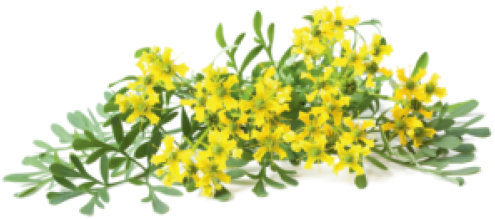
Scent – camphoraceous, slightly pine-like, spicy-herby, fresh, reviving, stimulating, warming, purifying.
There are more than 750 species in the Salvia genus and no scented garden would be complete without a bush of common sage (S. officinalis). Invaluable in the kitchen, sage is also one of the most ancient medicinal plants – the name salvia derives from the Latin salvere, to save, indicating its well-established reputation as a healing herb. Native to the Mediterranean region, it has soft, silvery oval-shaped leaves and a mass of deep blue or pinky-violet flowers in late summer. Like lavender and santolina, it has a woody base and evergreen leaves and reaches a height of about 60cm (2ft), lending structure to the kitchen or herb garden when other plants die down in winter. Sage is also a decorative shrub for the herbaceous border, especially since there are numerous species to choose from. Most sages require full sun and a well-drained soil to really flourish, although they are not fussy plants and will grow virtually anywhere. Clipping plants hard back every spring (after all danger of frost has passed), as well as later in the summer helps to keep them compact and stop them becoming leggy. Still it is best to replace plants every four years or so or when the stem becomes too woody. Sage is a fast grower and is easy to propagate from seed sown outdoors in spring or from softwood cuttings in late spring.
S. officinalis ‘Albiflora’ has white flowers; S. o. Purpurascens Group has dark purple leaves and is very ornamental; S. o. ‘Tricolor’ has leaves variegated purple, white and green and is slightly tender; while the leaves of S. o. ‘Icterina’ are coloured gold. Clary sage (S. sclarea) is a stout biennial or perennial herb, far more bold in appearance than common sage. Its erect flowering spike grows up to 1m (3ft) high; it has large woolly grey leaves with a hint of purple, and small soft-lilac flowers with pinkish bracts add an immediate touch of drama to the herb garden. S. s. var. turkestanica has pale blue and white flowers with pink bracts and smells extremely unpleasant. Spanish sage (S. lavandulifolia) is an evergreen shrub, similar to common sage but with narrower leaves and small blue-purple flowers; it is an excellent culinary sage with a scent reminiscent of spike lavender. There are also a wide range of tender or semitender varieties of sage with a range of intriguing scents, for example, S. elegans is a subtropical species with a pineapple scent and bright scarlet flowers. It makes a good pot plant, as do most sage species.
NOTE
Avoid sage during pregnancy. Do not use clary sage oil if you have been drinking alcohol or plan to do so, since it can induce a narcotic effect and exaggerate drunkenness.
• Aromatherapy applications – Essential oils are produced from the flowering tops of several species of sage including S. officinalis, S. lavandulifolia and S. sclarea, each having slightly different characteristics and properties. Clary sage oil has a sweet nutty-herbaceous scent and is used more frequently in aromatherapy than common sage oil, which is altogether harsher. Clary sage oil is used extensively for depression, nervous tension and stress-related disorders, having a pronounced euphoric, restorative and uplifting effect. Common and Spanish sage oil are both used primarily for respiratory infections, poor circulation and for hair care. The leaves of clary sage make an excellent eaude- cologne or toilet water – see page 75.
• Drying and decorative uses – Use dried flowers and leaves (of all varieties) in pot pourris. Clary sage is striking as a cut flower. Dried sage bundles thrown on the fire purify the air in a room, like rosemary or lavender. A sprig of leaves in the wardrobe will help repel moths. Fresh sage makes a good conditioning hair rinse.
• Culinary suggestions – In the kitchen, sage is best known as a stuffing for poultry but it can be used equally well with cheese dishes or vegetables.
• Health-giving properties – Sage leaves, boiled in water and drunk with honey and lemon juice, are excellent for relieving a sore throat and colds. A tonic tea made from the leaves is good for indigestion, cramps and nervous exhaustion.
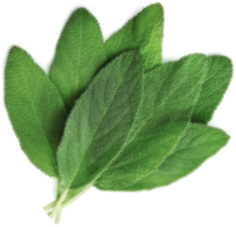
Scent – pungent slightly acrid, bitter, lemony-green, herby, stimulating, purifying.
This evergreen woody herb has silver-grey foliage and from midsummer until autumn a mass of small bright yellow, ball-shaped flowers. Native to the Mediterranean region, it is a tough plant that likes full sun and can tolerate even very poor soil – indeed, the foliage colour deteriorates if the soil is too rich. Cotton lavender was introduced to Britain during the sixteenth century as an ornamental plant, and became especially prized for creating intricate knot garden designs, which were very popular during the Elizabethan period. It grows to just 45cm (18in) high and makes an ideal low hedging plant or edging herb. However, when grown as a hedge it needs to be clipped frequently to prevent it from flowering and to maintain its compact shape.
Cotton lavender also looks good in a mixed herbal border, in a dry Mediterranean gravel bed or as a feature in its own right. It will thrive in pots, where its silver foliage can act as a foil for other ornamentals. The whole plant has a strong, slightly rank smell, a bit like Roman chamomile, to which it is related. Despite its common name, it is not a member of the lavender genus, although the finely cut coral-like leaves closely resemble those of Lavandula dentata. Plants are best propagated by cuttings taken in spring or late summer.
S. chamaecyparissus var. nana is a dwarf form 15cm (6in) high, ideal for rock gardens or pots; another dwarf cultivar, S. c. ‘Lemon Queen’ has narrow leaves and creamy flowers. S. rosmarinifolia subsp. rosmarinifolia has feathery greenygold foliage. S. pinnata subsp. neapolitana is a particularly good variety for drying.
• Aromatherapy applications – An essential oil can be produced by steam distillation from the seeds but it is little used in flavouring, perfumery or aromatherapy due to its high toxicity level.
• Drying and decorative uses – Most Santolina species will dry well for use in arrangements or in pot pourris. The dried herb also has excellent insecticidal properties and will help keep moths away from linen and clothes.
• Culinary suggestions – Cotton lavender is not recommended for flavouring due to its bitter taste and toxicity. It is, however, used in dried form as an ingredient in herbal tobacco.
• Health-giving properties – A decoction made from the flower and leaf of cotton lavender is used in herbal medicine to reduce skin inflammations and expel intestinal parasites.
NOTE
Not recommended for home use medicinally due to its toxicity.

Satureja hortensis and S. montana
Scent – fresh, herby, spicy, sharp, green-peppery, stimulating, warming, restorative, aphrodisiac.
Summer savory (S. hortensis) is a popular annual culinary herb with slender green leaves and small, pale lilac flowers. Although it is more delicate than winter savoury (S. montana) and needs to be replanted each year, summer savory is preferred for cooking, since it has a more refined flavour – it is also favoured for medicinal purposes. Winter savory is the perennial version with white flowers and smaller, dark green leaves. It forms a neater, more compact plant, making it a good edging plant in the herb garden or border, especially as it is semi-evergreen.
Winter savory is the best choice for container planting as it is an altogether tougher plant, requires less water and will thrive even in poor soil – although it is best given some protection over winter. Natives to southern Europe and North Africa, both winter and summer savory will tolerate most conditions (except extreme cold and wet), but prefer a light, well-drained soil in a sunny position. Both herbs will grow to a height of about 30cm (12in), although summer savory needs to be picked or trimmed regularly to prevent it from getting leggy. Both types can easily be grown from seed sown under glass in early spring, then planted outdoors once any danger of frost is past. Winter savory can also be propagated by softwood cuttings taken in spring.
The purple-flowered savory (S. coerulea) is a decorative garden plant with small purple flowers and dark green aromatic leaves. Creeping savory (S. spicigera) is a very attractive low-growing herb similar to thyme, with limegreen leaves and producing a mass of white flowers.
• Aromatherapy applications – An essential oil is produced by steam distillation from several savory species including S. hortensis, S. montana, S. thymbra and S. douglasii, mainly for use in flavouring and occasionally in perfumery. It is not employed in aromatherapy because the oil causes skin irritation.
• Drying and decorative uses – The leaves of summer savory dry well for decorative and culinary use. Store them in an airtight container.
• Culinary suggestions – Summer savory is also known as the bean herb, especially in America, since it enhances the flavour of all beans and helps prevent wind. It is also used for flavouring vegetable and egg dishes and is often added to rich meat recipes, as it aids digestion.
• Health-giving properties – A tea made from the fresh leaves of summer savory is good for digestive complaints, menstrual irregularities and respiratory conditions such as coughs, colds and (as a gargle) sore throats. Applied externally, the fresh leaves help bring relief from bee or wasp stings.
NOTE
Avoid use during pregnancy.
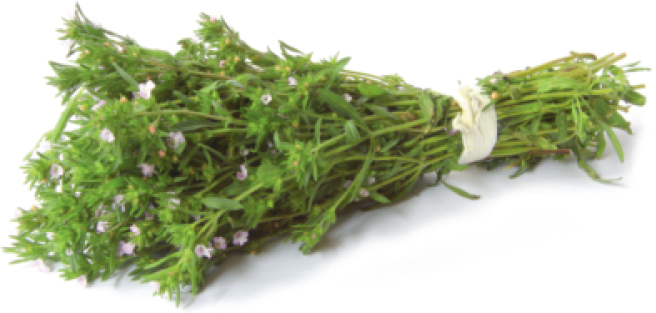
Scent – floral, orange blossom-like, coconut, slightly citrus, sweet, evocative, warming.
The fragrant golden-yellow flowers of Spanish broom or weavers’ broom (S. junceum), which are carried throughout summer, have a delightful sweet orange scent. It is a deciduous hardy shrub, with woody stems, almost without leaves, and the flowers are pea-like. Its height of 2.5–3m (8–10ft) makes it a valuable plant at the back of the border. Broom is native to southern Europe, and is a tolerant plant that grows best in sandy or alkaline soil, so is therefore especially suited to coastal gardens, although it grows equally well in cities. Plant small bushes in spring or early autumn in a spot that receives full sunshine. As Spanish broom self-seeds readily, it requires constant dead-heading but the ripe seed pods can be kept for propagation. For a supply of young seedlings, sow seeds in spring or autumn into sandy compost for planting out after the second growing season. Spanish broom is fast growing: trim bushes lightly in both spring and autumn to encourage growth and prevent them from becoming leggy.
The genus Spartium is generally considered to have only one species. Other recommended scented species include the Moroccan broom (Cytisus battandieri), a wonderful shrub found high up in the Atlas mountains. It bears large, fragrant yellow pea-like flowers that are pineapple scented. The yellow-flowered fragrant common broom (C. scoparius) grows wild in Britain and was once used medicinally. Members of the genus Genista have the advantage in that they are long-lived, unlike the Cytisus brooms. The medieval term planta genista – a sprig of broom – gave the name Plantagenet to English kings. Henry II even wore it on his cap. The Mount Etna broom (G. aetnensis), has sweetly scented yellow flowers and grows up to 5m (16ft) high.
• Aromatherapy applications – Spanish broom is grown in southern France and Spain for the absolute obtained from the dried flowers, known as genet and included in highquality floral perfumes. Spanish broom absolute is toxic and is not used in aromatherapy at all.
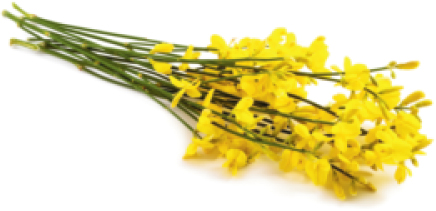
NOTE
Do not use Spanish broom (S. junceum) flowers or shoots at home for culinary or therapeutic purposes at all due to their toxicity. If you have any doubts about distinguishing between different species, do not use them at all.
• Drying and decorative uses – Dried flexible branches of broom were once used for their namesakes, brooms, and today can be used for basket weaving. The dried flowers can be used in pot pourris but these must be kept away from young children, because of their toxicity.
• Culinary suggestions – Spanish broom should not be used for culinary use. The roasted ground seeds of common broom pods (Cytisus scoparius) can be used as a coffee substitute. Its pickled buds are considered similar to capers, while before the advent of hops, the new shoots were used to flavour ale. Wine can be made from the flowers of the common broom (C. scoparius), combined with citrus fruit.
• Health-giving properties – Spanish broom, S. junceum, should not be used as a herbal remedy at home at all. The common room (Cytisus scoparius) was once considered a herbal cure for kidney and bladder complaints in the Middle Ages. A herbal tea made from common broom is used by medical herbalists as a diuretic, while the common broom tops boiled with dandelion root, flavoured with juniper berries and a touch of cayenne pepper make a lively tonic.
Scent – warm, spicy-herby, powerful, woody-green, refreshing, stimulating, purifying.
In the scented garden, thymes are essential for both their hardiness and their pungent, fresh aromatic scent. A whole area of the garden can even be devoted to a specific thyme bed or a thyme lawn, for there are many species and varieties, mostly edible and nearly all with valuable medicinal properties. They are obligingly evergreen, perennial subshrubs that thrive in dry sunny areas, in borders or amongst paving and on the edges of paths, where they release their strong fragrance when trodden upon. Thyme walks were very popular from the fifteenth through to the seventeenth centuries: they require little to thrive except good drainage and sun, and need minimal nourishment.
Many thymes are native to the Mediterranean region. The common thyme (T. vulgaris) is a bushy evergreen herb up to 30cm (1ft) high with a woody root and stem, small grey-green, oval aromatic leaves and pale purple or white flowers. It will spread quickly to form a thick mass, especially if it is trimmed lightly after flowering – this will also prevent it from becoming woody. Common thyme makes an excellent ground cover plant and is ideal for rockeries and all types of container planting. It is also very popular with bees and makes a good companion for cabbages, as it helps keep away insect pests. Most thymes are easily propagated by softwood cuttings in summer or by division in autumn.
There are a great many species and varieties of thyme, with flowers ranging from white to mauve, pink and crimson; the leaves can be green, grey, silver, golden or variegated. Cultivars of the common thyme include T. vulgaris ‘Erectus’, which is camphor-scented with upright growth and white flowers, and ‘Silver Posie’, with silveryvariegated leaves and a mass of mauve-pink flowers. The lemon-scented thyme (T. x citriodorus) is good for cooking and is frequently used in pot pourris; T. herba-barona has a caraway scent and T. ‘Fragrantissimus’ has orange-scented leaves. The wild creeping thyme (T. serpyllum), with its lilac-pink flowers, is perfect for a scented lawn or between paving stones. There are many cultivars of this wild thyme, such as T. s. ‘Vey’, which is very compact; ‘Annie Hall’, a popular pink variety; ‘Elfin’, diminutive with magenta-pink flowers; and ‘Russetings’, which has bronze-tinted foliage.
• Aromatherapy applications – An essential oil is made by water or steam distillation from the fresh or partially dried leaves and flowering tops of common thyme. The so-called red thyme oil is the crude distillate; white thyme oil is produced by further re-distillation or rectification, to remove some of the less desirable chemical constituents. Essential oil of serpolet is made from wild thyme (T. serpyllum), a valuable medicinal oil that is milder in effect. Many chemotypes of thyme oil can be produced by a single species, since a plant's chemical make-up can vary according to growing conditions. Chemotypes include the thymol and carvacrol (warming and active); the thuyanol type (penetrating and anti-viral); and milder linalool or citral (sweet scented, non-irritant), depending on the specific species they are extracted from. In aromatherapy, common thyme oil is mainly used to combat problems of the circulation, muscles and joints, such as arthritis, cellulitis, muscular aches and pains, oedema, poor circulation, rheumatism and sprains; plus respiratory conditions such as bronchitis, coughs, mouth and gum infections, sore throats and tonsillitis; and infectious diseases including chills, colds and flu. A warming massage oil can be made at home – see page 76.
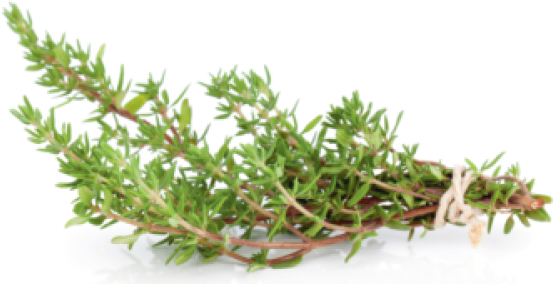
• Drying and decorative uses – Thymol, an active ingredient in common thyme oil, acts as a repellent to moths and flies; lay dried sprigs amongst linen. Used fresh in bath bags, thyme has a tonic, refreshing and cleansing effect on the skin.
• Culinary suggestions – Thyme is one of the mainstay herbs of the kitchen cupboard, being an essential ingredient in bouquet garni, along with sage, rosemary, parsley, marjoram and bay leaves. It is excellent with chicken and fish, in stuffings, and is used in many vegetable and cheese dishes. Use sprigs of the fresh herb in oils and vinegars and in mulled red wine.
• Health-giving properties – Medicinally, thyme has powerful antiseptic properties and, like rosemary and sage, was used as incense or to purify temples and homes. For centuries thyme was associated with the treatment of female ailments and used for nervous afflictions. Nicholas Culpeper recommended drinking a strong infusion of thyme as ‘a very effectual remedy for head-ache, giddiness and other disorders of that kind; and a certain remedy for that troublesome complaint, the nightmare’. Thyme tea, drunk with honey, is good for sore throats, chesty coughs and colds – it is also supposed to be useful in cases of drunkenness.
Scent – sweet, delicate, floral, slightly spicy, uplifting, peppery, stimulating, refreshing.
T. majus, the common nasturtium, is also known as Indian cress. Although native to the West Indies, Central and South America, it had become a familiar garden plant in Europe by the early seventeenth century. Tropaeolum as a genus comprises hardy and half-hardy annuals and perennials, including climbers and scramblers that can reach up to 2.5m (8ft). They are grown for their brightly coloured yellow, orange or red, sweet-scented, trumpetshaped flowers, produced from the middle of summer into autumn. There are also cream-coloured varieties. As scramblers they can be trained to climb over shrubs, through trellises or against walls, and are also a welcome addition to hanging baskets.
Nasturtiums are also good for companion planting, as they attract hoverflies as well as repelling whitefly and woolly aphids. Plant them alongside vegetables such as cabbages. They prefer to be planted in bright sunshine and T. majus in particular flowers best in poorer soil that is well drained. Planted in good soil, leaves are produced instead of an abundance of flowers. Grow common nasturtiums from seed in the spring: sow directly into the soil once the danger of frost is over.
T. majus is the common annual nasturtium: the ‘Gleam’ varieties have sweetly fragrant flowers and grow to 38cm (15in) high. These are semi-double plants with a trailing habit, bearing yellow, scarlet and orange flowers. T. majus ‘Empress of India’ is a small hardy plant, a fast and prolific annual carrying dark crimson attractive flowers from early summer to early autumn.
• Aromatherapy applications – The essential oil capucine extracted from common nasturtiums is used in modern seductive floral perfumes. It is not employed in aromatherapy.
• Drying and decorative uses – The fresh flowers last well in water and make simple posies. Dried nasturtium petals are colourful in pot pourris: dry the petals in a low oven so they retain their colour better.
• Culinary suggestions – Nasturtium leaves have a peppery taste like rocket and are delicious in salads. The flowers are also edible and make pretty decorations in salads or fruit punches. The green seeds can be pickled like capers, to which they are in fact related.
• Health-giving properties – Nasturtiums have medicinal benefits: the seeds have antibacterial properties and medical herbalists use an infusion of the leaves to treat urinary infections and bronchitis.
NOTE
Best avoid use during pregnancy.
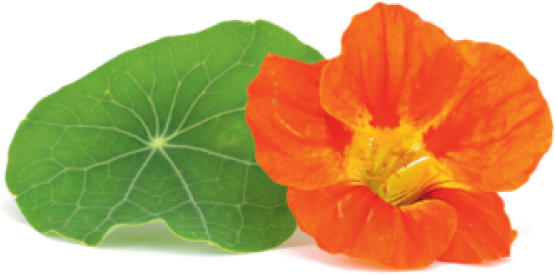
Scent – pungent, warm-woody, balsamic, musky, green, bitter-sweet, relaxing, narcotic.
Common valerian, also known as garden heliotrope, is a stately perennial herb up to 1.6m (6ft) high with a hollow stem, deeply dissected dark leaves and dense clusters of small pink or white flowers. It has short, thick greyish roots, largely showing above ground, which have a strong odour. The scent of the roots, especially when dried, attracts cats who find their pungent musky smell quite irresistible. They will also roll in the leaves, flattening the plant if given the chance.
Valerian root is one of the most powerful herbal remedies available for treating severe stress-related conditions, and was widely used in the treatment of shell-shock victims during the First World War. It has a pronounced painkilling and tranquillising effect on the entire nervous system and is mildly narcotic – however, in excess it can cause hallucinations, dizziness and agitation, so it must be used with caution. Common valerian is widely distributed throughout Europe and Western Asia. It prefers a moist loamy soil and some sun but will also tolerate a shady position. As an ornamental plant, V. officinalis forms an attractive backdrop to a floral border or the herb garden, sending up tall elegant flowering shoots in midsummer that have a honey-sweet scent. By nature, it is also suited to woodland sites or naturalistic plantings, for it likes to be cool around its roots and prefers to grow near water. It is generally beneficial to the garden as it attracts earthworms. If valerian is being grown mainly for medicinal purposes, the flowers should be cut back so the herb's energy is diverted into the rhizomes. Propagate plants by seed sown in spring or by root division in spring or autumn.
Common valerian (V. officinalis) should not be confused with red valerian (Centranthus ruber), a garden plant that seeds itself freely on sunny banks and walls. Spikenard (V. jatamansi) possesses similar medicinal properties to common valerian, while V. phu ‘Aurea’ is an attractive garden plant with rosettes of lemony-green foliage.
• Aromatherapy applications – An essential oil is produced by steam distillation from the rhizomes. In aromatherapy, the oil is used in moderation, mainly in combination with massage, for nervous conditions including insomnia, nervous indigestion, migraines, stress and nervous tension.
• Drying and decorative uses – Lift the rhizomes in the plant's second year after the leaves have died off, then, clean, slice and dry them, discarding all pale, fibrous roots. The root of spikenard is used in the East to scent cloth and bath water. An infusion of the rhizome of V. officinalis added to the bath is good for unwinding. Try it in a bath bag – see page 79.
• Culinary suggestions – There are no culinary uses for valerian species.
• Health-giving properties – Valerian has powerful antispasmodic, carminative, hypnotic, hypotensive and sedative effects; like hops, it is a depressant of the central nervous system. To make a soothing sedative tea, crush one teaspoon of the fresh or dried root in a cup of cold water and leave for 12 hours, then strain it well.
NOTE
Do not use valerian for more than two weeks at a time or in conjunction with sedatives or sleeping pills. Valerian is contra-indicated for those with liver problems.
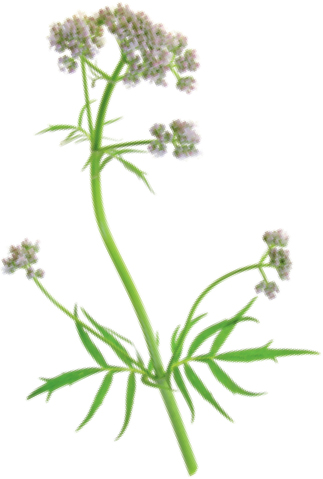
Scent – sweet, rich, floral, intense, comforting, uplifting, soothing.
The sweet violet is one of our most popular early spring flowers. V. odorata is native to Britain and is very fragrant and easy to grow, making it an intrinsic part of any aromatic garden. The very scent of the flowers is said to ‘comfort and strengthen the heart’. Both the Greeks and Romans loved the scent of violets – they were sacred to Aphrodite – and although the violet is a humble plant, it has captured many hearts. It was the symbol of love between Napoleon and the Empress Josephine, who had her wedding dress embroidered with violets.
The sweet violet is a small hardy perennial plant with dark green, heart-shaped leaves, fragrant violet-blue flowers and an oblique rhizome root. Though barely 8cm (3in) high, it spreads rapidly by sending out root runners, eventually forming a sweetly scented green carpet. Violets thrive best in a fairly rich, moist soil, in semi-shade, and they do not like the heat. They are easy to propagate, either by seed sown in the autumn under glass then planting out in spring, by dividing established clumps after flowering or by taking root cuttings in late spring. Violets also display the additional blessing of self-seeding abundantly. Parma violets, such as ‘Duchesse de Parme’ and ‘Marie Louise’, make good container plants for scenting a room or conservatory, especially as they are not reliably hardy.
Cultivars of V. odorata come in a variety of colours from white to pink and purple. Sweet violets often flower twice, in spring and again in autumn and sometimes through a mild winter. Parma violets have single or double flowers with a very sweet fragrance in a range of rich colours – as grown by Josephine at Malmaison. The double varieties are not fully hardy and are easily spoiled in wet weather, and therefore need to be protected under glass. For Gertrude Jekyll, there was a unique beauty and delicate refinement in the subtle fragrance of the wild wood violet (V. reichenbachiana) which was ‘never overdone’.
• Aromatherapy applications – An absolute perfume material is made from both the fresh leaves and the flowers: both are very valuable perfumery ingredients. The leaf absolute has a strong green odour with a delicate floral undertone and is used in aromatherapy for treating eczema, thread veins and refining the pores. The flowers have a sedative effect, good for nervous exhaustion, dizziness, headaches and insomnia. A scented water made from the fresh flowers and a perfume can be made at home – see pages 74–5.
• Drying and decorative uses – A posy of fresh violets is one of the traditional tokens of love. Dried flowers and leaves can be used in pot pourris, especially combined with violet-scented orris root.
• Culinary suggestions – The fresh flowers can be added to salads or crystallised violets can be used for decoration for cakes and puddings.
• Health-giving properties – A syrup made from the flowers has anti-inflammatory, antiseptic, expectorant and laxative properties. The roots and leaves are also used in herbal medicine.
